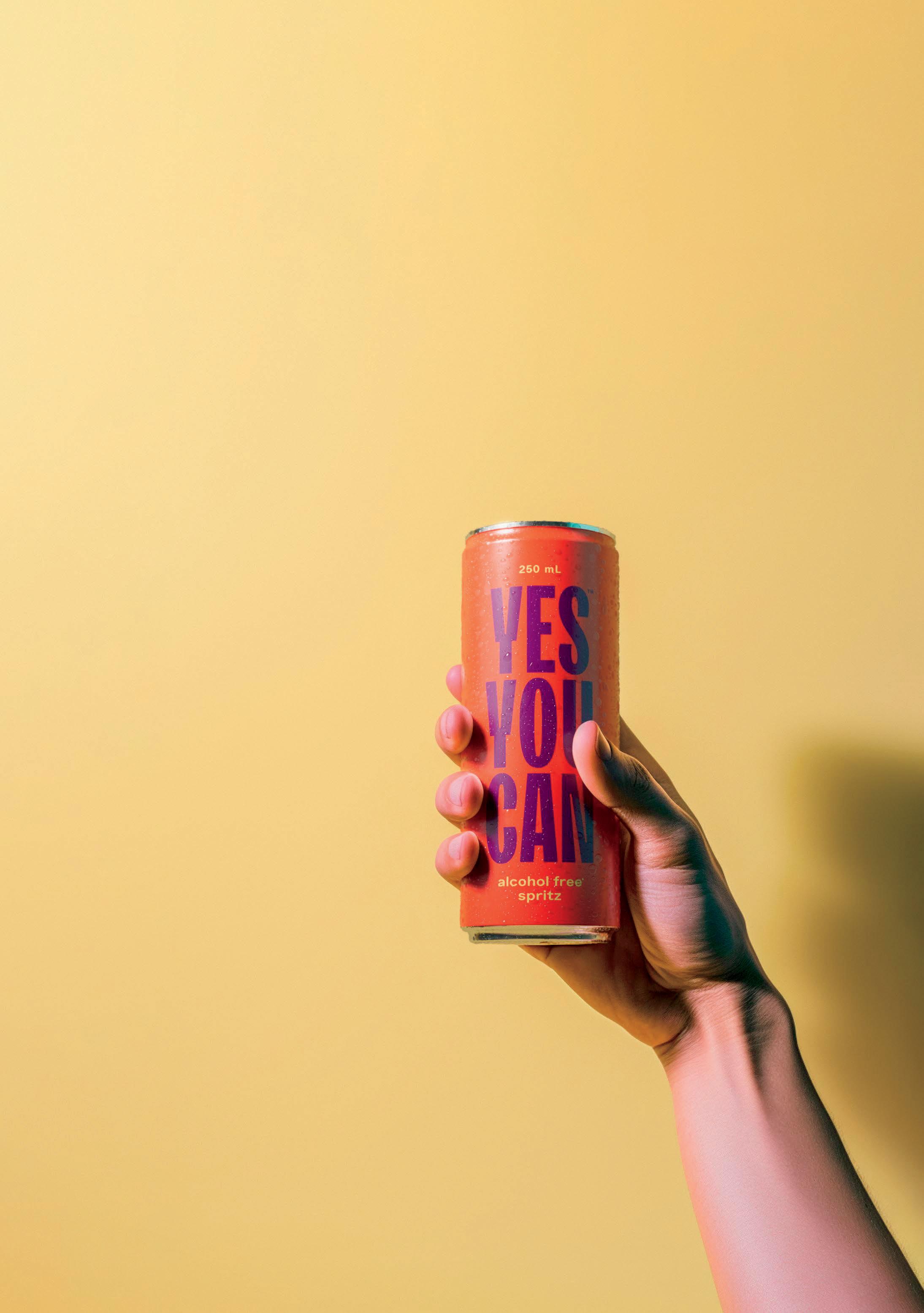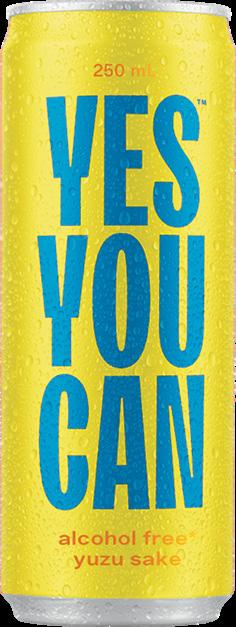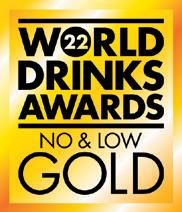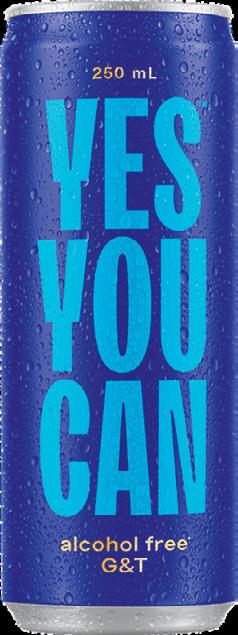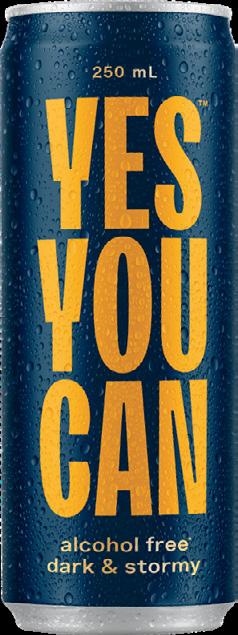0% CHANCE OF MISSING OUT THIS JULY.
0%* alcohol. 100% flavour.







0%* alcohol. 100% flavour.






Welcome to the June issue of National Liquor News, and my last full issue as Editor.
It’s time for me to say goodbye to this magazine, and to you awesome readers, after four years. It has been an absolutely incredible journey to edit these past 30 issues and a pleasure to bring you all the top industry news, insights and analysis to help your business be the best it can be.
This role has taken me around the country and the world, giving me the opportunity to meet so many of the amazing people that make this industry so great around the world (this month that happened to include the pictured Chris Fletcher, Master Distiller at Jack Daniel’s). Australia’s liquor and hospitality industry as a whole is just incredible – what I have seen, learned, (and tasted) in this role has made for the best of experiences, made me a lifelong industry supporter, and of course, a passionate reader of NLN from here on out.
Looking to this issue itself means looking to the end of something else – the financial year. At this time of year, we always check in with the leaders of Australia’s key independent banner groups, to hear about how they are going, what they’re working on, and what trends they are seeing in the market. You can find Seamus May’s interviews with eight banner groups starting from page 26.
June does mark the start of something too –winter. As the season brings the slowing of social occasions, this can present a low-pressure chance to try some beverages other than alcohol. There are also a few ‘abstinence occasions’ on the calendar in
coming months (think Dry July and OcSober, for example). Caoimhe Hanrahan-Lawrence reviews the current state of the no and low alcohol market from page 44, so your store can be well equipped to cater to the needs of these consumers.
Rounding out this issue is our annual bumper Shiraz tasting, with almost 100 wines tasted by our expert panel. Their top picks in three price brackets are listed from page 54. And as usual, you’ll find all the latest news and insights throughout the rest of these pages, including informative articles from regular contributors such as Retail Drinks Australia, Strikeforce, Wine Australia, Independent Brewers Association, eLease Lawyers, the Liquor Stores Association of WA and Circana.
I’ll be around for a little while longer after this issue goes to print, but before I go I want to give a final thanks to the wonderful humans at The Intermedia Group. Shoutout to all of the wider team who I’ve worked alongside over the years, with a special thanks for the guidance of my editorial mentors Andy Young, Vanessa Cavasinni and Deb Jackson, commercial guru Shane T Williams, design genius Kea Thorburn and supportive Publisher Paul Wootton.
It’s time to sign off for the last time, but don’t be a stranger – feel free to find me on LinkedIn and stay in touch. All the best!
PUBLISHED BY:
Food and Beverage Media Pty Ltd
A division of The Intermedia Group 41 Bridge Road GLEBE NSW Australia 2037 Tel: 02 9660 2113 Fax: 02 9660 4419
Publisher: Paul Wootton pwootton@intermedia.com.au
Editor: Brydie Allen ballen@intermedia.com.au
Journalist: Seamus May smay@intermedia.com.au
Journalist: Caoimhe Hanrahan-Lawrence chanrahanlawrence@intermedia.com.au

General Manager Sales –Liquor & Hospitality Group: Shane T. Williams stwilliams@intermedia.com.au

Group Art Director –Liquor and Hospitality: Kea Thorburn kthorburn@intermedia.com.au
Production Manager: Jacqui Cooper jacqui@intermedia.com.au
Subscription Rates
1yr (11 issues) for $70.00 (inc GST)
2yrs (22 issues)for $112.00 (inc GST)
– Saving 20% 3yrs (33 issues) for $147.00 (inc GST)
– Saving 30%
To subscribe and to view other overseas rates visit www.intermedia.com.au or Call: 1800 651 422 (Mon – Fri 8:30-5pm AEST) Email: subscriptions@intermedia.com.au
Brydie Allen, EditorDisclaimer
This publication is published by Food and Beverage Media Pty Ltd (the “Publisher”). Materials in this publication have been created by a variety of different entities and, to the extent permitted by law, the Publisher accepts no liability for materials created by others. All materials should be considered protected by Australian and international intellectual property laws. Unless you are authorised by law or the copyright owner to do so, you may not copy any of the materials. The mention of a product or service, person or company in this publication does not indicate the Publisher’s endorsement. The views expressed in this publication do not necessarily represent the opinion of the Publisher, its agents, company officers or employees. Any use of the information contained in this publication is at the sole risk of the person using that information. The user should make independent enquiries as to the accuracy of the information before relying on that information. All express or implied terms, conditions, warranties, statements, assurances and representations in relation to the Publisher, its publications and its services are expressly excluded save for those conditions and warranties which must be implied under the laws of any State of Australia or the provisions of Division 2 of Part V of the Trade Practices Act 1974 and any statutory modification or re-enactment thereof. To the extent permitted by law, the Publisher will not be liable for any damages including special, exemplary, punitive or consequential damages (including but not limited to economic loss or loss of profit or revenue or loss of opportunity) or indirect loss or damage of any kind arising in contract, tort or otherwise, even if advised of the possibility of such loss of profits or damages. While we use our best endeavours to ensure accuracy of the materials we create, to the extent permitted by law, the Publisher excludes all liability for loss resulting from any inaccuracies or false or misleading statements that may appear in this publication.
Copyright © 2023 - Food and Beverage Media Pty Ltd
At Naked Life, we’re passionate about moments worth celebrating and believe that you should be able to do so without compromising on taste. That’s why we artfully distill botanicals with quality ingredients, creating beautifully crafted cocktails. Non-alcoholic, sugar-free and low on calories.


Speak to your local Craft Revolution sales rep or major wholesaler about kickstarting a non-alcoholic offering with our internationally awarded and Australia’s #1 selling range of fifteen RTD cocktails.

info@craftrevolution.com.au

19 Strikeforce: Challenging times
23 LSA WA: A positive first half of the year
26 Banner Groups: Rallying through adversity
58 Retailer Profile: Wine Experience
21 Independent Brewers Association: Revised 10-year roadmap to meet new challenges
22 Wine Australia: Alternatives in Australian wine
24 Circana: The why behind the buy

44 No and Low Alcohol: Keep it on the NOLO
52 Brew Review: Top beers
54 Wine Tasting Review: Shiraz
JOIN US FOR THE
Friday 18 August 2023
Lunch 12.30pm
Grand Ballroom Hyatt Regency
Sydney
$195 (WCA members)
$225 (non-members)
Full table $1941 (table of 10)
Giesen Group is expanding its range of zero per cent New Zealand wines with a sparkling offering to come later in the year, and heavy investment in technology.
There’s no doubt about it, the no and low alcohol category is booming around the world, with the IWSR reporting that the category hit US$11bn in key markets (including Australia) in 2022, up from US$8bn in 2018.
According to the 2022 Mindbody Wellness Index Australia, more than 60 per cent of people are also more focused on health and wellness, suggesting a vast latent market of potential purchasers.
Thankfully, Giesen Group has a full range of high quality zero alcohol wines that can immediately allow retailers to appeal to this wide subsection of non-alcoholic drinkers. Plus, Giesen’s non-alcoholic wines are only 14 calories per 100ml serving, allowing retailers to further cater to those consumers behind the ‘better for you’ trend.
The Giesen 0% range boasts five varietals: Pinot Gris, Riesling (a Gold Medal winner at the 2023 World Alcohol Free Awards), Rosé, Merlot, and a non-alcoholic rendition of Marlborough’s world-famous Sauvignon Blanc. And the brand is further widening its appeal, with the addition of Giesen 0% Sparkling Brut to come in late 2023.
Duncan Shouler, Director of Winemaking at Giesen Group, said the new product will give consumers more opportunities to enjoy great tasting wines. It further bolsters a compelling range for retailers to stock, leveraging the strong qualities of New Zealand’s wine industry.
“The Giesen 0% Sparkling Brut is a super exciting addition to our non-alcoholic wine range,” Shouler said.

“We love being able to offer wine consumers a zeroalcohol option for all occasions, and the Sparkling Brut really brings another dimension to the range –especially celebrations.
“New Zealand wine lends itself extremely well to sparkling wine styles, due to the purity of fruit flavour and great natural acidity. As such, we can’t wait to get our delicious, fruity and playfully sparkling zero alcohol example into the market.”
Giesen Group’s range also includes the award-winning Ara Zero line, featuring Ara Zero Sauvignon Blanc (which recently picked up a Gold Medal at the World Alcohol Free Awards) and the recently launched Ara Zero Rosé.

A key point of difference for Giesen across both zero alcohol ranges is its technology. A leader in non-alcoholic innovation, Giesen employs spinning cone technology to gently remove alcohol from the wines at low temperatures, creating a higher quality final product, made from real wines that have undergone the traditional production process.
Giesen is adding to its capabilities in this space too, investing in another spinning cone device that will increase production ten-fold, and also allow for further boundary-pushing innovation.
“We have seen fantastic growth in the zero alcohol wine category, and have become leaders in this space now,” Shouler said.
“The SCC10,000 spinning cone machine will give us the ability to increase our production, and also increase our innovation with the product range.
“It will free up more time for research and development work to continue to really push the boundaries of what’s possible in the zero alcohol wine space, and to really drive wine quality.” ■
To find out more about how your store could benefit from ranging Giesen 0% and Ara Zero, contact Brand Ambassador, Dan Chorley at dan.chorley@giesengroup.com.au




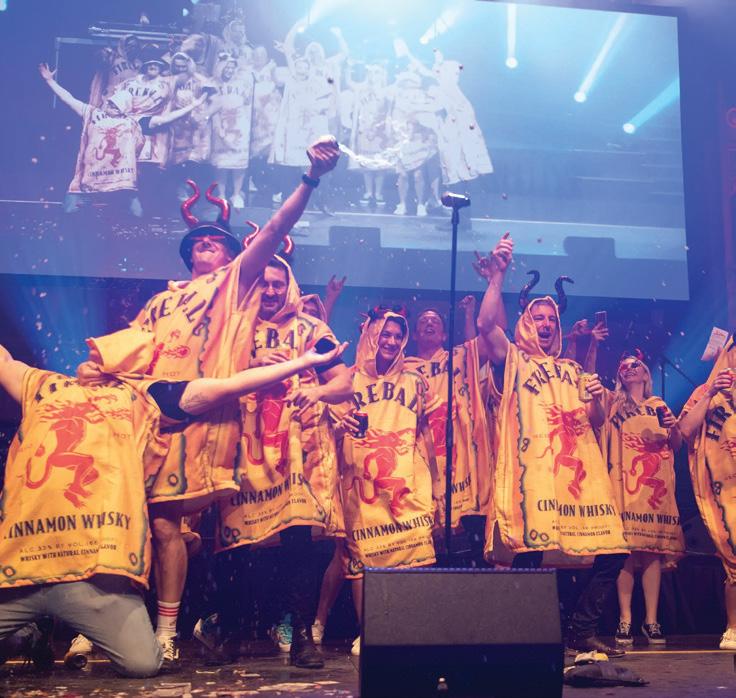

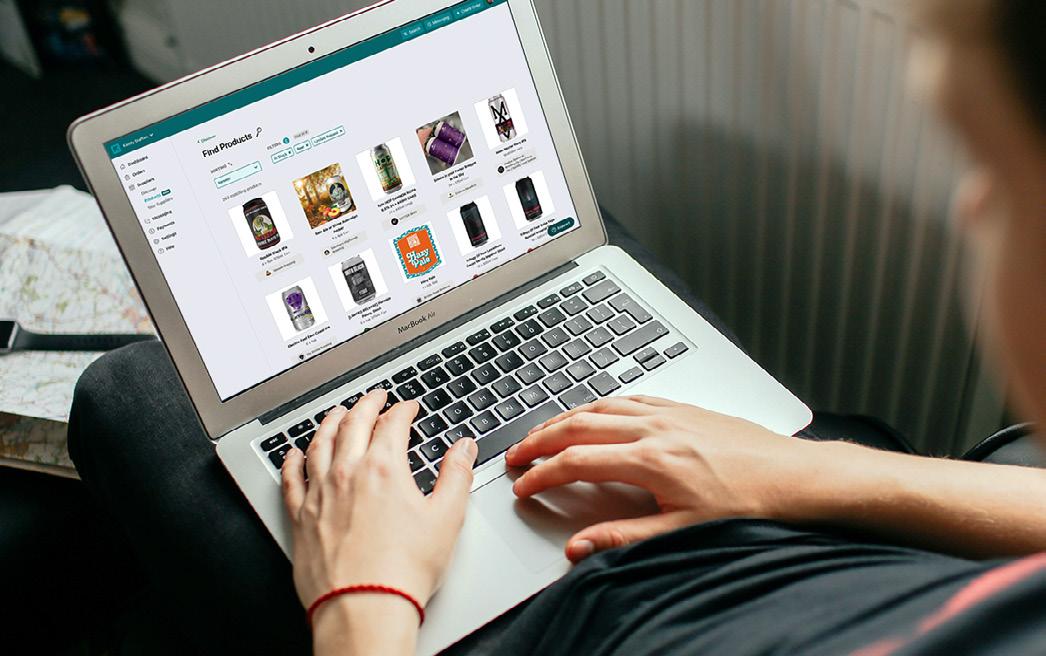
May was a busy month for announcements coming from online drinks companies, with BoozeBud announcing it was going into voluntary administration, and Gintonica going up for sale.
Early in the month, online retailer BoozeBud stopped accepting orders and laid off all staff, as Michael Brereton and Sean Wengel of William Buck were appointed as Voluntary Administrators by the director of BoozeBud Holdings Ltd and the director of Pocko Pty Ltd (trading as BoozeBud).
At the time, Brereton said the Administrators were undertaking an urgent assessment of the businesses’ financial position and exploring a sale of the business and assets or the recapitalisation by way of a Deed of Company Arrangement.
Within a fortnight came the announcement about Gintonica being placed up for sale by Founder, David Box. The company was known for its gin tasting packages, monthly gin subscription service and advent calendars, all featuring miniature bottlings, and had also recently branched into whisky to do similiar under the WhiskyRocks name.
The Gintonica sale would include the business names, databases, websites, stock and media content.
Box said: “The team and I are proud to have contributed to the promotion and rise in popularity of Australian gin and, more recently, whisky, but now it is time to hand over the reins to new passionate gin lovers who, I am sure, will take it to the next level.”
From here, Box said he will focus on distillery services under the name ‘Spirited Bottlers’, which will be a contract filling, capping and bottle labelling service, as well as a supplier of bespoke packaging and Gintonica’s exclusively sourced 30ml and 50ml bottles.

Last month, Kaddy Group announced it had gone into voluntary administration, appointing Rajiv Goyal, Chris Johnson and Joseph Hayes of Wexted Advisors as the administrators to undertake an urgent assessment of the group. The news came after Kaddy Group has been in a trading halt on the ASX since February, requesting extensions for a voluntary suspension pending an announcement “in relation to capital raising.”
The wider Kaddy Group includes many arms, with the Fulfilment division shut down with the administration announcement, but the Marketplace division continuing to operate as normal. While it has not yet been announced what would happen to the rest of the company (at the time of writing), there has been good news for this Marketplace division, thanks to a new partnership with Lecca, a leading Singapore based food and beverage focused investment company.
This new partnership will see a revamped business model known as Kaddy Reborn, which promises to offer a simpler business model, refreshed management team, wider range of products, more competitive pricing and improved application features for its suppliers and customers allowing the seamless delivery of product.
The initiative will be led by Lecca alongside Kaddy CEO, Steve Voorma, who said the move fills both entities with “confidence and excitement.”
“We have actively listened to the market and implemented a range of initiatives to enhance our offerings. With Lecca’s expertise, support and funding we have significantly strengthened our market position,” Voorma said.
“This collaboration, coupled with our simplified yet enhanced business model, will enable us to deliver an unparalleled market offering, setting the industry standard for both suppliers and buyers.”
More information about what to expect from Kaddy Reborn is available via The Shout here: https://bit.ly/KaddyReborn
Two leading drinks companies have announced new Australian leadership in the past month, with key appointments announced at BacardiMartini Australia and Coles Liquor.
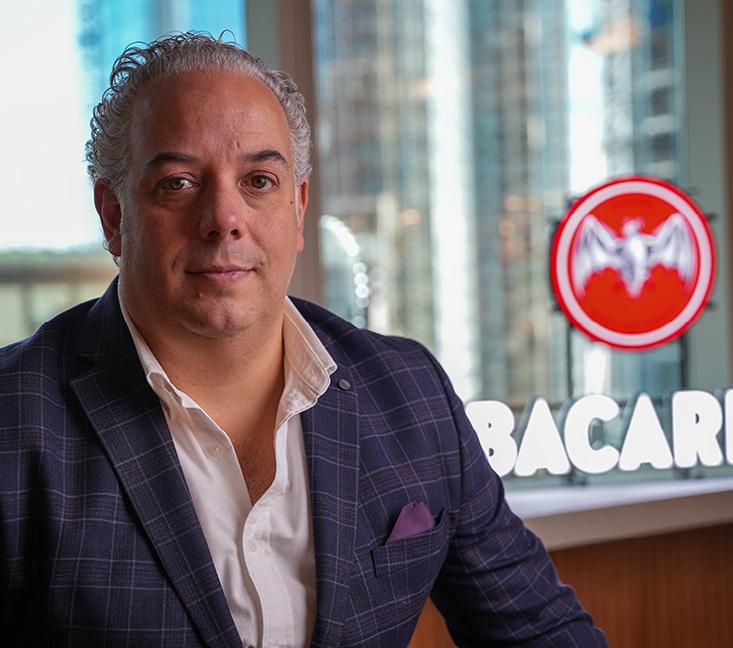
Bacardi Limited announced Luiz Schmidt as Managing Director of the company’s Australian and New Zealand operations, returning from Panama after serving as Regional Marketing Director for Bacardi in Latin America and the Caribbean. A highly specialised FMCG marketing professional, Schmidt has over two decades of international experience across a range of roles, with a reputation for outstanding long-term strategy development, new product development, team building, innovation, and growth within the global premium spirits market.
Meanwhile, Coles has announced Michael Courtney has been promoted to the role of Chief Executive Coles Liquor Group, replacing Darren Blackhurst who is returning to the UK to be with family. This new role for Courtney comes after leading Coles Express for four years, where he delivered a winning strategy and oversaw a successful transition to Viva Energy.


➤ Euromonitor reveals the megatrends influencing consumer behaviour
➤ Think outside the box with cask wine
➤ Australian brewers win big at global beer marketing awards
Sign up to our fortnightly Newsletter by going to this URL: https://theshout.com.au/ national-liquor-news/ subscribe/
BAM Wine Logistics has announced the establishment of new operations in WA after acquiring the WA operations of Kaddy Fulfilment after the arm went into administration. With this, BAM entered into a long-term agreement to lease the Forrestfield site previously occupied by Kaddy Fulfilment, acquiring critical operational assets in the process and also offering employment to many former Kaddy staff members
Daniel Van Vemde, General Manager of BAM Wine Logistics, said: “We are committed to being the premier wine storage and logistics provider in the country, and expansion into Western Australia was a logical next step. We pride ourselves on providing exceptional service to our clients and their customers. We look forward to developing our WA network and offering for many years to come.”
BAM is an independently run but integral part of the Joval Group of companies, which has been operating for over 40 years across all areas of the wine industry.
Tim Menting, CEO of Joval Group, said: “We have always been committed to setting a new service standard in everything we do, and view wine logistics as critically important to the distribution chain. We see BAM’s entry into the Perth market as being both a great strategic move for our group, as well as the right thing to do for an industry in turmoil following Kaddy Fulfilment’s sudden collapse.”
“We hope that by making this swift acquisition, we are able to help get things back on track in WA and minimise the pain being felt by countless wine and beverage producers, distributors, retailers and hospitality venues.”
BrightSide Executive Search is the only dedicated drinks recruitment specialist nationally and has been a trusted advisor to the industry for well over a decade. Through accessing its wide-reaching network of potential candidates, BrightSide takes the hassle out of recruitment for drinks businesses of all sizes, advising how they can stay nimble and competitive in a tight market to attract the absolute right person for each role. The latest BrightSide success stories below showcase their capability to manage volume recruitment projects, ensuring businesses like Fever-Tree have full teams of qualified talent as they transition to a direct model.
Ben Asby is loving being back in drinks, bringing a wealth of experience to his new role as National Sales Manager at Fever-Tree.

Richard Irwin is looking forward to utilising his extensive international drinks experience as BDM QLD for Fever-Tree.

Francesco Casarotto is thrilled to be representing a brand he knows and loves again, as BDM QLD for Fever-Tree.
Dean Adams’ passion, experience and enthusiasm will see him hit the ground running as BDM NSW with Fever-Tree.
Adam Hunter comes with strong drinks experience and entrepreneurial flair to his new role as BDM NSW with Fever-Tree.
Callie Raymond is excited to utilise her industry experience and passion for spirits in her new role as BDM VIC with Fever-Tree.

Andrew Grech brings a unique combination of horticultural and hospitality experience to his new role as BDM VIC with Fever-Tree.

Evan LeBlanc comes with extensive drinks experience and passion for spirits to his new role as BDM SA for Fever-Tree.

Lindsay Cardno will use her established relationships and experience as Key Account Manager WA with Fever-Tree.


Steve Carr’s energy, experience and passion is a huge asset to the Sydney team as Trade Marketing Manager for Fever-Tree.



For more information go to www.brightside.careers or to look for current opportunities check out the BrightSide LinkedIn page: www.linkedin.com/company/bright-side-executive-search

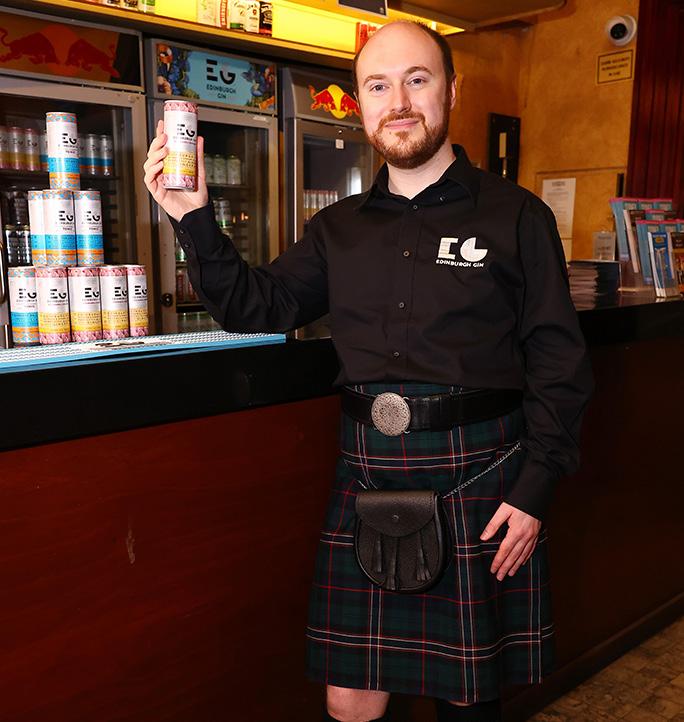
Edinburgh Gin got in the spirit of fun last month, becoming the official spirit of the Sydney Comedy Festival after being a long-standing spirit partner of the Edinburgh Fringe Festival. The Sydney event included shows featuring local and international acts at venues across the city, allowing the brand to introduce itself and its commitment to the Australian market. To celebrate the partnership, Edinburgh Gin activated a special takeover of the Factory Theatre courtyard, which was dubbed the Edinburgh Gin Wonderland and included the presence of Global Brand Ambassador, Philip Kingscott from Scotland.


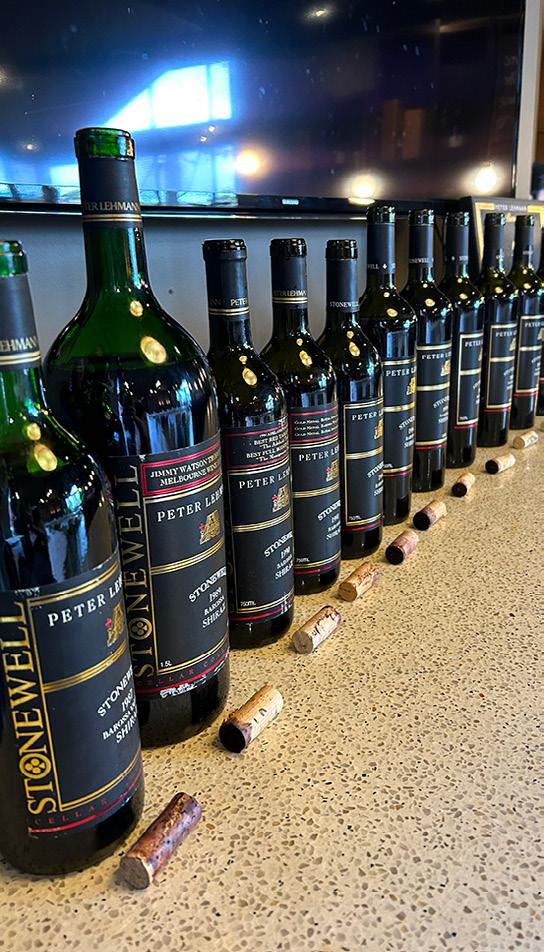
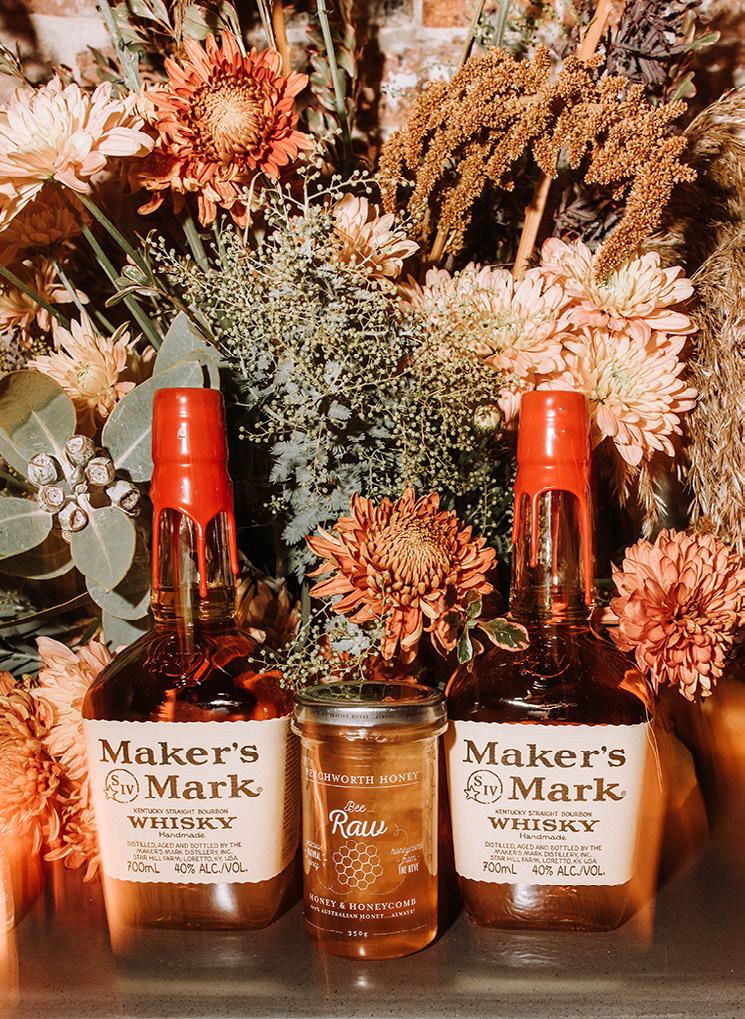
Kentucky’s Maker’s Mark Whisky has teamed up with Australia’s Beechworth Honey on the Goldrush Experience, paying homage to their respective ‘liquid golds’. The collaboration was born from the shared values of both companies, with generations of expertise and knowledge at the core of both sides. Sustainability is also incredibly important to both companies, with Maker’s Mark one of the largest B Corp certified distilleries in the world and Beechworth working to create a healthy and sustainable environment. The Goldrush Experience event took place at Hinchcliff House in Sydney, where guests were treated to both a tasting of Maker’s Mark and Beechworth Honey, also brought together in a special Goldrush cocktail. Throughout the night, the event inspired attendees to honour tradition and heritage alongside positive innovation and collaboration, in order to create a better future.
Barossa winery Peter Lehmann has celebrated 30 vintages of its iconic Stonewell Shiraz wine, stretching from 1987 to 2017. Throughout all 30 (and the unreleased vintages set to follow), the brand has kept a core goal of sourcing the most exceptional intense and robust flavoured fruit, in partnership with its network of highly trusted growers. The milestone 30 year occasion was marked by the team touring to a few select locations to showcase some of the key vintages along the way, that illustrate the development of the wine throughout time and the impact that vintage conditions can make each year. At each event, guests tasted a range of Stonewell vintages, led by Chief Winemaker Nigel Westblade, Viticulturalist Jade Rogge and Brand Ambassador Malcolm Stopp.
The Barossa’s Krondorf Wines has unveiled its next release, with five extraordinary wines selected from the highly anticipated 2021 vintage. The brand has said these wines continue the Krondorf legacy that has been developed over the years to now sit under Paragon Wine Estates, a collection of high quality wineries that are owned by Endeavour Group. Krondorf launched this latest selection of red wines at an intimate event in Sydney, where guests tasted across all SKUs, including the 2019 King’s Mantle Shiraz, 2021 Kingship Cabernet Sauvignon, 2021 Old Salem Barossa Shiraz and 2021 Stone Altar Shiraz and Grenache wines. Head Winemaker Nick Badrice took attendees through the tasting, describing his aim to take a minimalist approach and let the wines express themselves in the glass.
Renowned British chef, restauranteur and television personality, Gordon Ramsay, has launched his own range of wines in Australia. This is the first country outside of the UK to receive the Gordon Ramsay Italian Collection, which was created in partnership with winemaker Alberto Antonini.

The range includes three blends – the Bianco, Rosso and Rosato. These wines combine Ramsay’s passion for the very best ingredients with Antonini’s reputation for contemporary winemaking, resulting in a pioneering decision to create the wines with fruit from two different regions (Tuscany and Abruzzo).
After launching the wines in the UK in 2021, Ramsay discussed why he chose Australia as the next destination for them.
“Just like Italy has a special place in my heart; I have spent some incredibly happy times in Australia and many of those moments were made even better by a beautiful glass of wine, so it was only natural I chose to bring my collection here,” he said.
The Gordon Ramsay Italian Collection is distributed locally by Oatley Fine Wines, with Sales and Marketing Director, Rob Hassan, noting: “We feel very excited to have such an esteemed global chef as Gordon Ramsay joining our portfolio with his new selection of wines. We look forward to sharing the range with wine lovers around the country and developing a wonderful reputation for this collection that captures the heart and soul of Italian winemaking.”
For the first time in eight years, Lion has unveiled a new packaging design for the entire Tooheys line. The aim was to give the iconic brand a fresh, modern look, while still paying homage to its 154-year history.
Also in the redesign, Tooheys Old has changed colour from maroon to the original all-black colour scheme. Tooheys Extra Dry has become even more distinct in its clear glass bottle, with brightened colours and the established date replaced with a product descriptor.
Chris Allan, Head of Core Beer Marketing at Lion, said: “Tooheys is a brand that has over a century and a half of stories under its belt – so there is a challenge in moving too far away from the past and our rich legacy. We feel the new packaging pays tribute to our proud heritage as well as modernising in a way that allows the core brand assets to shine.”
The new packaging was designed by creative agency Weave, which worked collaboratively with Lion on the project.
Mick Boston, Head of Design at Lion, said: “It is such a fine line refreshing an iconic brand like Tooheys, retaining all the well-loved memory structures whilst setting the brand up for the future. We’re confident we have created a look that honours our impressive past but keeps the brand moving forward.”
Dan Cookson, creative director at Weave, agreed, and said: “This wasn’t about throwing yesterday away. We needed to both respect the past and have the courage to move forward, reintroducing it to a new audience while also rekindling the love held by existing Tooheys fans.”

A non-alcoholic version of Asahi Super Dry has arrived in Australia. Asahi Super Dry 0.0% is part of Asahi Beverages’ range of no, low, and mid-strength beers, from which the company garners around 30 per cent of its beer sales.

Kym Bonollo, Head of International and Craft at Asahi Beverages, said: “Asahi Super Dry is an internationally recognised premium beer brand and Japan’s leading beer. Now, Australian beer lovers looking to moderate their alcohol consumption can enjoy Asahi Super Dry’s signature crisp and refreshing taste without the alcohol.
“As demand for alcohol-free alternatives grows, we’re seeing more people seek out brewed adult beverages such as non-alcohol beers that don’t compromise on taste or quality. Developed through extensive research and trials, Asahi Super Dry 0.0% is an elevated option,” Bonollo commented.
The Australian launch will be supported by a multi-platform advertising campaign. Asahi Super Dry 0.0% will be sold in bottle format nationally, with cans exclusively available through Endeavour Group at Dan Murphy’s and BWS.
Mighty Craft has continued its efforts in championing local small-batch distillers by entering an exclusive distribution deal with Mark Watkins from Mt Uncle Distillery. The new partnership will see Mighty Craft bring the distillery’s Agave Australis and FNG Rum Co. beverages to consumers nationwide.

Mighty Craft Director, Mark Haysman, said: “We had a look at some of the cocktail and beverage trends happening right now and there’s been a real resurgence in the popularity of rums and in tequila and mezcal.
“These spirits are world class and are an important addition to the Mighty Craft portfolio.”
The Agave Australis range includes three products: unaged Agave Australis Silver; Agave Australia Rested (matured in red wine barrels for two months); and Agave Australis Aged, which has been in reconditioned, ex-red wine American Oak barrels for two years. These products are made with blue agave plants Watkins first planted in 2012, after visiting Jalisco in Mexico in 2010, and noticing the similarities between it and his home in the Queensland tropics.
The FNQ Rum Co. brand includes Iridium Australian Rum, aged for five years in reconditioned American oak barrels that held red wine; Iridium X, aged for 10 years and available in limited quantities; and an unaged Australian cane spirit called Platinum.
This new partnership with Mt Uncle Distillery comes after Mighty Craft secured investor commitments to raise $5.2 million in equity, partly aimed at accelerating the growth of the company’s spirits portfolio.
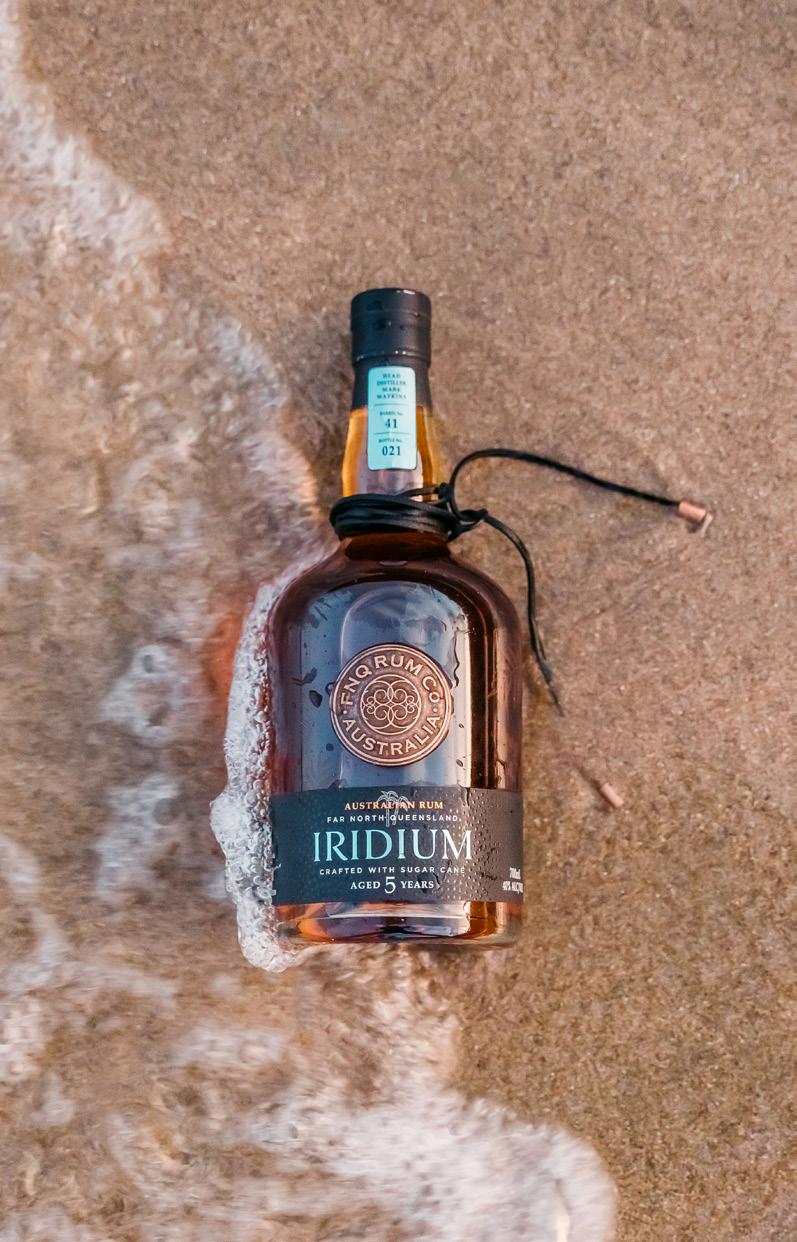
Wolf Blass has launched its latest annual Luxury Collection, releasing five wines across three price points that reflect the label’s history of quality wines. Founded in 1966 by Wolfgang Blass, the winery is a highly celebrated Australian label in the Treasury Premium Brands portfolio.
Chris Hatcher, Wolf Blass Chief Winemaker, said: “Wolf forged a new path in luxury Australian wines, always setting a much higher standard amongst his peers and this philosophy remains as relevant today to the 2023 Luxury Collection as when he first began over 50 years ago.
The wines of the 2023 Wolf Blass Luxury Collection are: Grey Label Piccadilly Valley Chardonnay 2022; Grey Label McLaren Vale Shiraz 2021; Grey Label Langhorne Creek Cabernet Shiraz 2021; Black Label Barossa, Langhorne Creek, McLaren Vale Cabernet Shiraz Malbec 2021; and Platinum Label Medlands Vineyard, Barossa Valley Shiraz 2021.
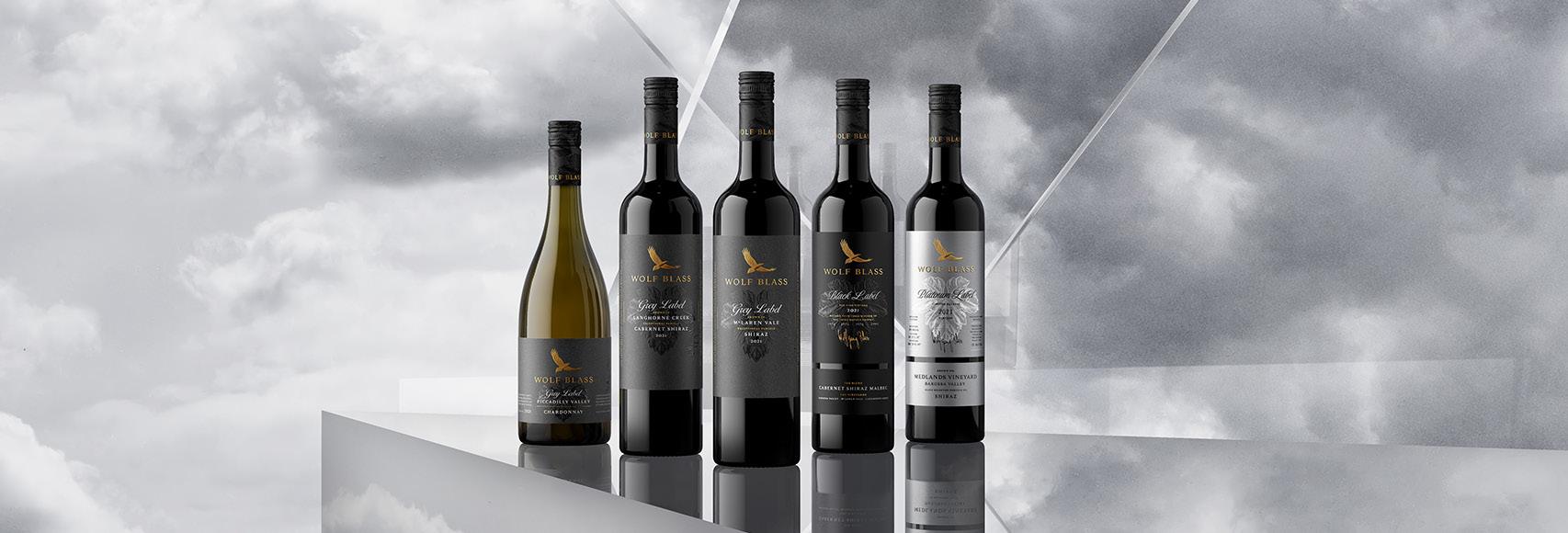
“Individually and collectively, these wines have been consistently recognised the world over. Sophisticated and multi-layered, they are equally traditional yet contemporary, showcasing the Wolf Blass hallmarks of power and elegance,” concluded Hatcher.
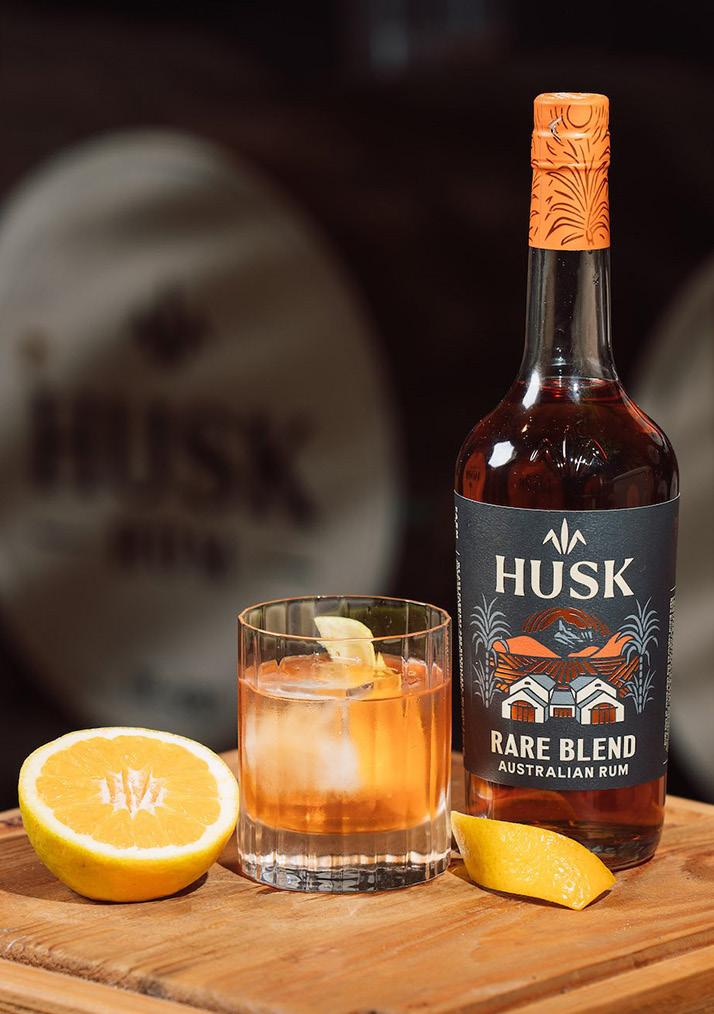
Australian distiller Husk Rum has released its new creation, Rare Blend, a prime example of how the brand is redefining the rum category.
Husk Head Distiller, Quentin Brival, said the new rum uniquely reflects the terroir of the coastal land between Queensland and NSW, where the Husk Farm Distillery lies.
“As Australia’s only farm to bottle rum distillery, we make Husk Rum using fresh cane juice grown on our farm and have focussed on creating a flavour profile reflective of our local region, the Caldera Coast,” said Brival.
“Rare Blend is a made from two styles of rum. The first is a seasonal 100 per cent single estate cane juice rum, our signature style which is dry and adds complexity and depth to the final product. The second is a rum made from Tweed Valley cane honey, which is evaporated cane juice. Cane honey is sweet, rich, and pure which creates a very smooth and round rum with fruity and floral notes.”
Paul Messenger, CEO of Husk Rum, adds that this latest creation is driven by the evolving tastes of Aussie consumers in the rum category.
“As rising consumer interest and the emergence of premium brands expand the category, modern perceptions of rum extend well beyond the traditional rum and coke. New styles and flavour profiles present opportunities to showcase the versatility of rum in high-end cocktails and new consumer trends elevating the category and educating consumers,” he said.
There’s a new local player in the aperitif market, bringing together a love of the traditional Italian aperitivo occasion with Australian native ingredients.

Ragazzi e Succo Aperitivo was created by Tom Hoff after 25 years in the hospitality industry. The product aims to be beautifully balanced to the tastes of consumers, masterfully blending 26 sustainably sourced botanicals, with classic amaro foundations harmonising with wattle seed, river mint, rosella flowers and more.
“During the development process, I kept in mind that many aperitivos focus solely on being either bitter or sweet, and so I turned my effort to delivering what consumers enjoy,” Hoff said. Ragazzi e Succo Aperitivo comes in 750ml bottles, with tasting notes describing mandarin, pink grapefruit, lemon and bitter orange alongside robust spices and a herbaceous bittersweet finish. Hoff’s serving suggestions include both as a substitution in classic cocktails, or with lemon juice and tonic over ice, which is the mix found in Ragazzi e Succo Aperitivo’s RTD can too.

Maritime Tasmanian whisky distiller, Waubs Harbour, has just launched its official first release whisky range. The family run distillery was founded by husband and wife team, Tim and Bec Polmear, in partnership with Tim’s brother Rob Polmear, previously Head of Production at Lark Distillery and Head Distiller at Overeem Whisky. The team’s first official releases have been eagerly awaited since the distillery’s preview series, launched in early 2022.
“The launch of our official first release whiskies is momentous for Waubs Harbour. While we have been established for over five years, due to the time it takes to set up a premium distillery production facility and to make and mature hundreds of casks of whisky, this is really just the beginning for us,” said Tim.
The new Flagship Series is a core range of three single malt whiskies – Waubs Original (43 per cent ABV), Port Storm (48 per cent ABV) and Founder’s Reserve (62 per cent ABV). For two weeks prior to the launch, Waubs Harbour auctioned off bottle number one of the Founder’s Reserve SKU via Whisky Auctions Tasmania, raising $4800 for the Great Southern Reef Foundation.
The launch was celebrated at the official opening of the distillery, complete with a ribbon cutting ceremony by Tasmanian Premier, Jeremy Rockliff MP. Big names of the Tasmanian distilling and tourism industries gathered for the occasion, including Bill Lark (Lark Distillery), Patrick Maguire (Sullivans Cove), Casey Overeem (Overeem Whisky), Sarah Clark (Tourism Tasmania), and Grace Keath (East Coast Tourism).
University of Oxford’s leading sensory academic, Professor Charles Spence, has collaborated with award-winning String Musicians Australia, to create a music track that’s scientifically proven to enhance the bold flavours of Jack Daniel’s Bonded.

The track includes melodic piano to enhance notes of caramel, low-pitched brooding cello to enhance notes of oak, and high tempo sharp violin to enhance notes of spice.
Professor Spence says: “The Sound of Bonded is built on years of research exploring the surprising connection between sound and taste… The research suggests that when you listen to the track while sipping Jack Daniel’s Bonded whiskey, the flavour notes will come to life in an even bolder, more enjoyable way.”
This innovation expands on the recent launch of Jack Daniel’s Bonded, the first super-premium release from the brand in 25 years. The whiskey has been created with select barrels that add more depth and character to the 50 per cent ABV liquid.
Jack Daniel’s Tennessee Whiskey Master Distiller, Chris Fletcher, says: “We’re constantly looking for new ways to elevate the tasting experience of our whiskey. Jack Daniel’s and music have always had a special connection, and what a better way to bring the two together than with a tailored piece of music that’s proven to bring out the bold and exceptional flavour notes of Bonded.”
The Sound of Bonded was launched in Australia during a visit from Fletcher. Music and whiskey lovers can recreate the experience at home with instructions and music via the Jack Daniel’s website: https://bit.ly/3okxf6m
One of the most marked trends in liquor retailing in recent years has been the pivot towards online alcohol sales and delivery. Whilst this trend was accelerated during COVID-19, the online alcohol sector is projected to continue growing over the coming years. As these services have expanded in popularity, governments have demonstrated an increased desire to pursue regulation in complement to the Retail Drinks Online Alcohol Sale and Delivery Code of Conduct.
The Code continues to enhance compliance in the responsible online sale and delivery of alcohol since it was first launched in July 2019. We know this because of the nearly 20,000 compliance audits conducted on signatories, which comprise well over 80 per cent of all online alcohol sales.

The Code also continues to help inform and shape the development of e-commerce regulation across Australia. The Queensland Government is currently examining regulations regarding online alcohol sales and deliveries, following on from similar consultations in New South Wales in 2020 and Victoria in 2021. Despite the sector receiving increased media scrutiny in Queensland, these regulatory reforms have been in the pipeline for several years with the Palaszczuk Government committing to undertaking a regulatory review as a direct result of Retail Drinks’ advocacy. In participating in this consultation, we will be aiming to ensure close alignment between the Code and the eventual regulatory framework in Queensland.
In addition to the Code, Retail Drinks, in partnership with Frontier Economics, has produced
the most comprehensive research report on the Australian online alcohol delivery sector to date. This report is based on transactional data as provided by Retail Drinks members, which has never been seen. The report addresses key knowledge gaps across the sector, including the times and locations of deliveries as well as the typical demographic characteristics of consumers. The report will provide another valuable resource to policy makers in attempting to gain a greater understanding of the sector as regulatory frameworks are considered. This report is far more detailed than other reports on the sector as it is based on millions of verifiable sales transactions.
Lastly, we will also be undertaking a two-year review of the Code later this year. As part of this process, all potential updates to the Retail Drinks Code will be vetted by a select committee consisting of major industry representatives, including small and large retailers, as well as delivery companies. The purpose of the review process is to ensure the Code remains a robust, best-practice and fit for purpose framework accounting for the rapid changes occurring in in the online alcohol sales and delivery sector. Previous changes to the Code have included widening its remit to capture sales by third-party marketplaces.
Retail Drinks is immensely proud of the thoughtleadership role we have played in the online alcohol sale and delivery space over several years and we look forward to continuing our contribution to important regulatory processes concerning the sector in the future. ■
 CEO, Michael Waters, discusses the organisation’s focus on the online sector.
CEO, Michael Waters, discusses the organisation’s focus on the online sector.
Michael Waters
CEO
Retail Drinks Australia
“Retail Drinks is immensely proud of the thoughtleadership role we have played in the online alcohol sale and delivery space over several years.”
Retail Drinks continues to inform and shape development of online alcohol regulatory frameworks
What should the range on offer be? What products are on trend, and which are not? Which products are driving sales and margin? How much inventory should I be carrying?
These are just some of the questions that retailers ask themselves almost every day.
The much-reported inflationary pressure that households and retailers are facing makes informed decisions even more important. Shoppers are forced to modify their behaviour as savings built up over the past few years are depleted by higher mortgage payments, rents, grocery, fuel, and energy bills.
Typically, households will attempt to offset costof-living increases by eating more at home, trading down for cheaper products, and shopping at retailers they perceive to be doing better at managing prices.
While it is tempting to go down the lowest price route, margin erosion and the increased cost of doing business make this approach untenable in the long term.
It is worth noting that during times of economic uncertainty households also trade up based on occasion. For example, a portion of the savings they make by eating in instead of dining out is allocated to rewarding themselves, creating an opportunity for retailers to upsell. With this in mind, a balanced range of value, mid-tier, and premium offerings is a must.
So, what else are retailers doing to sustain their customer base and cash flow?

There is a plethora of options that include, but
are not limited to, lowest price guarantees, exclusive member offers, and curated offers based on an individual’s previous purchases.
Product offerings and ranges are being curated using demographic information to best match the store’s local catchment area and purchasing behaviours.
Bundling seems to be back in vogue, which encourages shoppers to increase their spending in return for savings.
Retail brands continue to invest in store refreshes to generate latent interest and encourage shoppers through their doors.

With their online presence, retailers offer express delivery to time-poor shoppers, free shipping over a set purchase amount, digital gifting, and leverage their sustainability credentials.
Finally, suppliers always seek to increase their sales share in every retail outlet. This provides an opportunity to create an ‘event’ or ‘occasion’ to generate an incremental sale or attract new shoppers into the store.
Allocation of space and rotation of promotional products in that space, in a highly visual area of the store, keeps the offer fresh and interesting.
Ultimately, there is no single approach or magic formula to guarantee success. ‘Right product, right place, right time’ is the common thread that underpins any strategy to entice shoppers in the door, build loyalty and grow revenue. ■
“‘Right product, right place, right time’ is the common thread that underpins any strategy to entice shoppers in the door, build loyalty and grow revenue.”
Stephen Wilson Category & Insights ManagerStrikeforce Stephen Wilson, Category and Insights Manager at Strikeforce, suggests how operators can navigate current economic pressures.
Before signing a commercial lease, it’s essential for tenants to be aware of the costs that can increase the overall expense of leasing.
Some of the main hidden costs in commercial leases include:
• Maintenance and repairs: Commercial leases often require tenants to maintain the leased property and cover the costs of any repairs needed during the lease term. These costs can be significant and unexpected, especially if there is significant wear and tear on the property over time. Before signing a commercial lease, it’s essential to discuss the maintenance and repair requirements with the landlord and negotiate a fair agreement that takes into account the age and condition of the property. It is advisable to try and avoid repair due to fair wear and tear, structural and capital expenses.
• Common area fees: These fees are the costs associated with maintaining and repairing common areas, such as hallways, parking lots, and elevators. While these fees can vary significantly, they are often a percentage of the tenant’s total rent payment. Tenants need to negotiate these fees to ensure that they are either capped or that major items such as capital expenses are covered by the landlord.
• Operating expenses: In addition to rent, tenants may be responsible for a portion of the property’s operating expenses, such as property taxes, insurance, and utilities. It’s crucial to understand the full scope of these expenses and negotiate a fair agreement. If the lease is a retail lease, then you should obtain a Disclosure Statement that outlines the outgoings payable in detail.
• Renewal options: Many commercial leases include renewal options that allow tenants to extend the lease term beyond the initial agreement. However, these renewals often come with increased rent payments and additional fees including legal fees.

• Security deposits: Commercial leases typically require tenants to provide a security deposit upfront, which can be a significant expense.
• Improvements and alterations: If a tenant wants to make any improvements or alterations to the leased space, they may be required to cover the costs themselves. It may also be possible to obtain a contribution from the landlord to decrease this cost to the tenant.
In conclusion, commercial leases come with several additional costs that businesses need to be aware of before signing any agreement. These costs can add up quickly and significantly increase the overall expense of leasing, making it crucial to negotiate and understand all terms upfront.
By carefully reviewing the lease agreement and discussing any potential expenses with the landlord, businesses can make informed decisions and ensure that leasing remains a cost-effective option for their needs.
It is also advisable to obtain legal advice from a lawyer who specialises in leases to provide you with guidance. They should be able to help negotiate to decrease these costs by capping them, removing prohibited outgoings and negotiating the removal of other items to provide a fairer and more costeffective lease. ■

Marianna Idas
Principal eLease Lawyers
“Commercial leases come with several additional costs that businesses need to be aware of before signing any agreement.”
Marianna Idas, Principal at eLease Lawyers, details some key things for commercial leaseholders to watch out for.
As we here at the IBA read The Shout and National Liquor News religiously ,we know that times are once again challenging for the alcohol industry. Like all associations we have been working on trying to understand the breadth and depth of the issues that our members and industry are facing, and to crystal-ball gaze on what the future might present.
While our 10-year plan, Future Brew – Tapping the Potential remains highly relevant, market conditions since its completion have evolved, and the mindsight of the IBA and members has changed from one of driving rapid growth to short-term member stability; solidifying the market share gains of the last decade; continuing to drive long-term macro advocacy agenda, and appropriately resourcing the IBA and tightening the focus of our agenda/remit.
Last month IBA Chairman Richard Watkins announced that we had revised our priorities into a three-year plan with a focus on advocacy, Independent Seal marketing direct to consumer, business sustainability and IBA health – ensuring we survive to continue to support our nearly 600 members.
While we will continue to advocate and respond at a ‘local’ level, our renewed focus will be to try and find solutions for the myriad of challenges currently facing Australian brewers. Here’s just a taste of what breweries are currently having to navigate:
1. The ongoing struggle of carrying an
excise debt. It was great to defer excise during the height of the pandemic but in many instances the payback options are not sustainable as well as keeping up with current obligations.
2. The beer excise is linked to the Consumer Price Index (CPI) and automatically raises twice a year in August and February. Pegged to inflation, the hikes amounted to almost eight per cent in 2022.

3. We already pay the fourth highest tax on beer in the world, sadly, soon to be the third highest.
4. Cost of red tape regulation, for example: pregnancy warning labelling, licensing, permits etc.
5. Cost and ease of development.
6. Increase in the costs of doing business, power, consumables, ingredients, packaging, freight etc.
7. Less disposable income due to the rising cost of living.
8. Labour and skills shortages and therefore demands for higher wages.
9. Reduced distribution points and greater competition for shelf space.
10. The ‘alcohol opposition’ are well funded and have a focused agenda. On a lighter note, we launched our first ever direct to consumer marketing campaign which aims to raise awareness of the Independent Seal and what it stands for – more than ever
we want to capitalise on the hyper local trend.
The national campaign is going very well with over 11M impressions as a direct result of the ad and over 5,000 people clicking through to the Ask For Indie websitewww.askforindiebeer.com.au
Once there, they can find out what independent beer is, why it’s important to buy independent and most importantly where to find it.
This is the first phase of a three year campaign and is giving us some great insights into where our consumers like to be in the digital world.

There are no surprises that smartphones are the best performing devices or that Sunday, when consumers are relaxing and enjoying their down time, is when they are clicking through.
We recently chatted to our pals at the Brewers Association in the USA to understand their journey of the Independent Craft Brewer Seal and they agreed that ensuring consumers understand what it means is one of the most important things an association can do for its members. It is our point of difference, and we need to keep educating, not only to consumers directly but via the trade.
Some of our trade partners have really gotten behind the buy local, buy independent message, but we look forward to broadening those conversations. ■
There are well over 120 varieties of winegrapes currently grown in Australia*, of which the top 10 reds and top 10 whites account for more than 95 per cent of all wine produced.
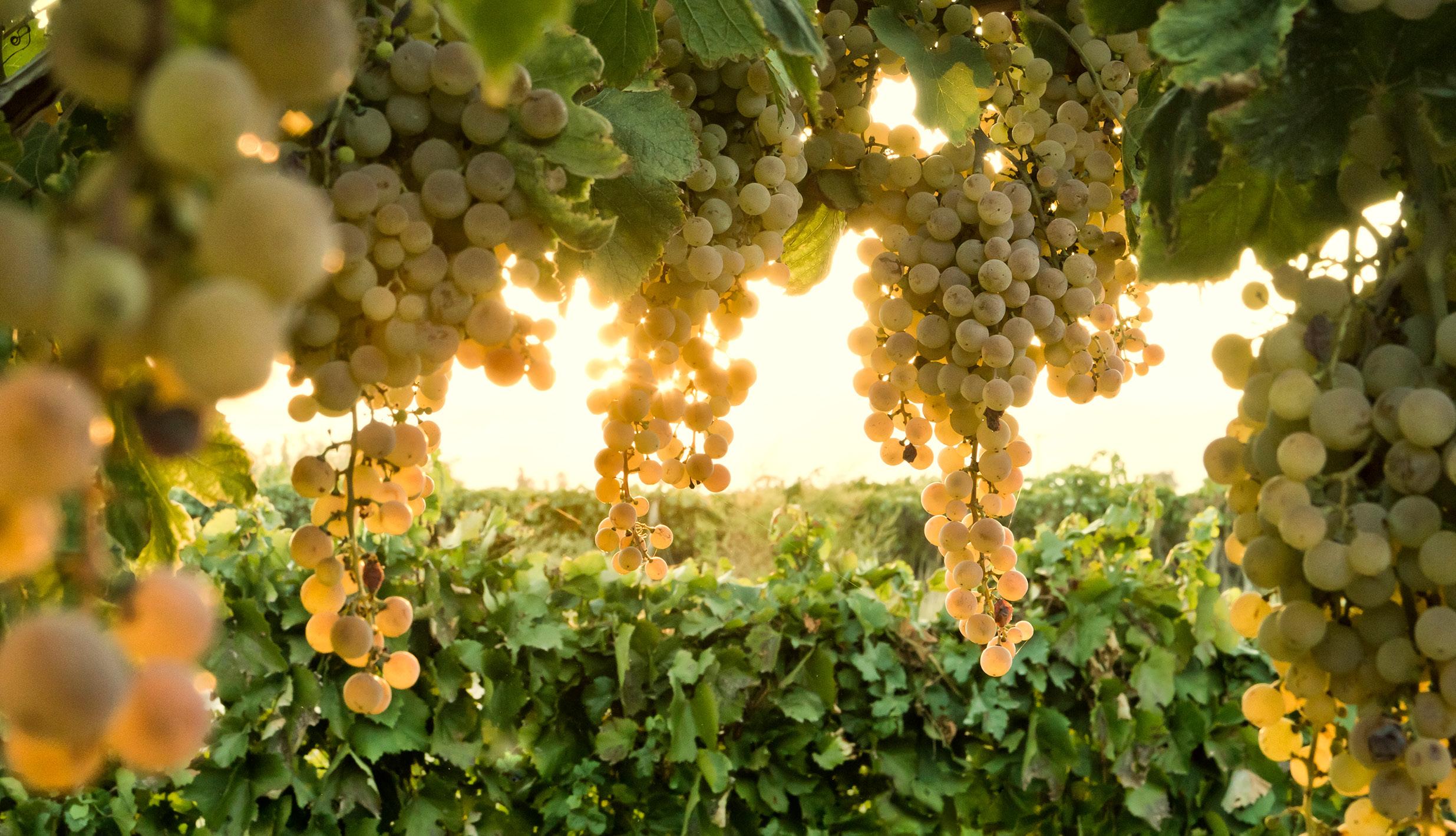
That leaves around 100 varieties to make up the ‘alternative’ landscape – together accounting for just five per cent of Australia’s wine production. So, if you’re interested in alternative variety wines, how can you possibly choose between them?
One way to look at which alternative varieties are currently growing in popularity is to look at trends in the number of entries in the Australian Alternative Varieties Wine Show (AAVWS) over time. This wine show – held in Mildura, Victoria, each year for the past 21 years – has seen more than 1200 entries in its long history, all of which are documented in a comprehensive database.
Analysis of the database conducted by Wine Australia indicates that the strongest growing varieties over time have been Tempranillo, Fiano and Nero d’Avola. Montepulciano has shown strong growth in the past two years but does not have a long history in the competition (Figure 1).

Of these, Tempranillo and Sangiovese have the longest history in the competition and have generally dominated in terms of share until being overtaken by Fiano in 2021.
Meanwhile, the varieties that have decreased the most in popularity (measured in terms of number of entries) over the past 20 years include Viognier, Nebbiolo and Mataro/Mourvedre.
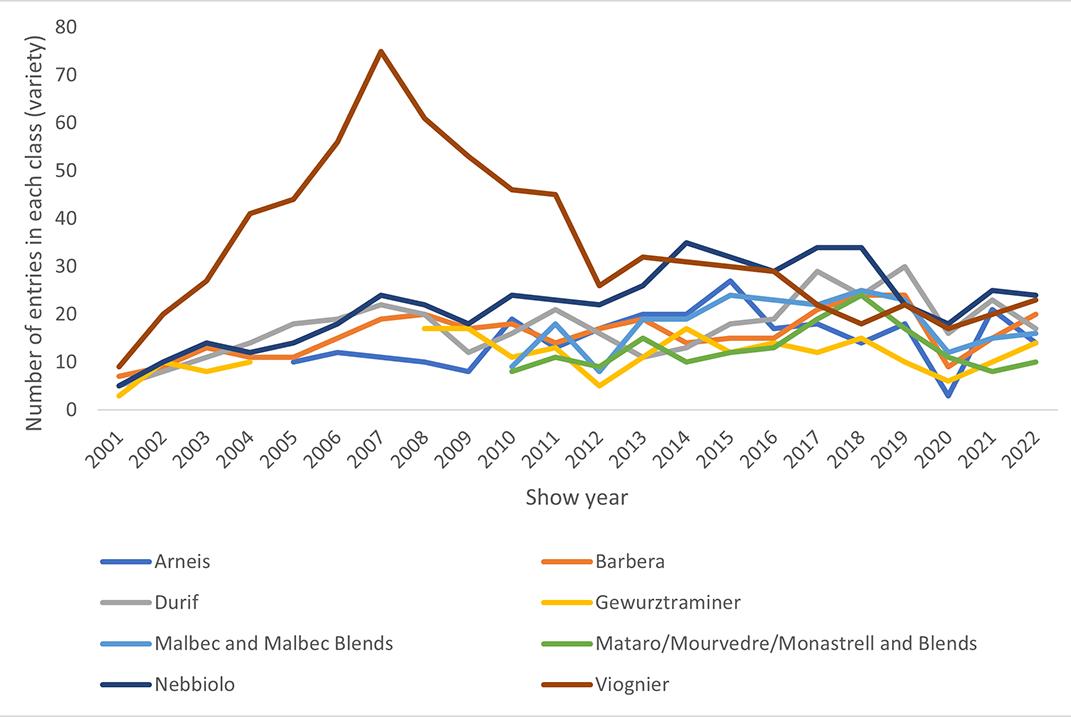
Viognier peaked with 75 entries in 2007 (compared with 69 entries for Sangiovese in the same year) but has since declined to 23 in 2022. Nebbiolo peaked at 35 entries in 2013 and declined to 24 in 2022 (Figure 2).
With the exception of Nebbiolo and Viognier, most of these
varieties have retained a similar share of around two to three per cent for the past 10 to 15 years. Nebbiolo peaked at five per cent in 2014 and has since declined to three per cent, while Viognier has declined from a peak of 13 per cent in 2007 to around three per cent in 2022. ■
 *According to the Wine Australia National Vintage Survey 2022.
Figure 1: Strongest growing varieties over time in the AAVWS
Figure 2: Varieties declining most over time in the AAVWS
*According to the Wine Australia National Vintage Survey 2022.
Figure 1: Strongest growing varieties over time in the AAVWS
Figure 2: Varieties declining most over time in the AAVWS
It’s been a great first half of the year for the Liquor Stores Association of Western Australia (LSA WA).
The association began kicking goals for its members early in the year, launching a new partnership with Bendigo Bank and Tyro Eftpos Solutions. This exclusive partnership netted significant value for members in the form of highly competitive merchant fees for associated point of sale transactions.
The positivity continued into the following months, with the highly anticipated return of the LSA WA Sundowner on the Swan event on the last day of March.
This is the second time the association has hosted the event and it has again been dubbed a great success. More than 100 people turned out despite the grey weather, with good representation from retailers, suppliers and government officials. This included WA Liberal Leader Libby Mettam MLA and Minister Paul Papalia CSC MLA, who gave an address on behalf of the WA Premier.
This year the event again had OzHarvest WA as its charity partner, and raised enough money to provide 3000 meals for those in need.
Peter Kapsanis, Media and Government Relations Manager for LSA WA, said the Sundowner provided a great atmosphere
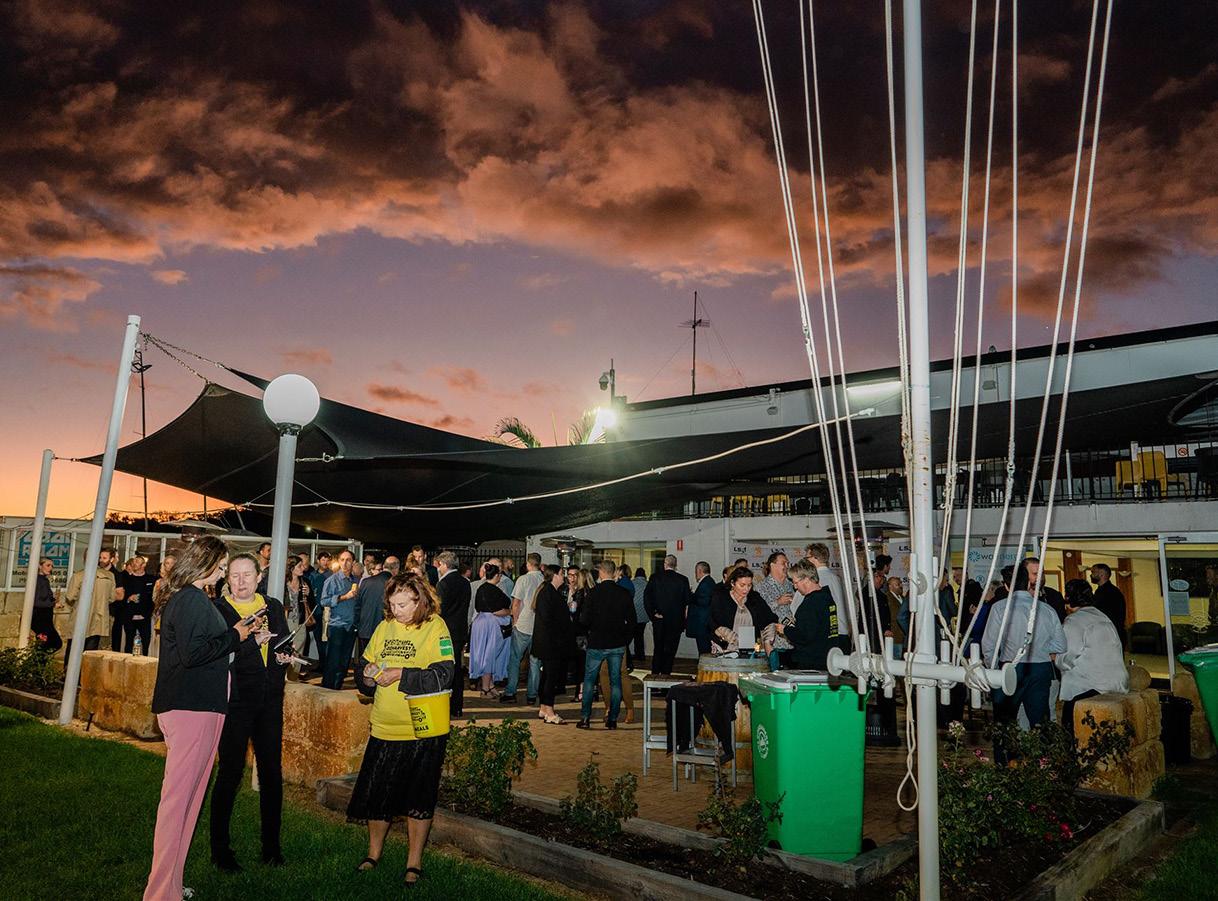
for the industry to come together in a laid back setting.
“Overall it was hugely successful, despite the gloomy weather… it gave LSA members the chance to see what the association is doing for the benefit of our 300 members across the state, to broaden our horizons and add more value for them,” Kapsanis said.
“Our aim is to do good and paint the sector in a positive light, and we do that year on year.”
The 2023 Sundowner was supported by LSA WA partners including Lion, Containers for Change, WA Energy and Bendigo Bank.
More recently, the LSA WA has also introduced its new board, with Michael Cartwright joining the team following the tragic loss of former board member Anita Grace last year. The board has now been ratified, with Cartwright joining Chair Lou Spagnolo, Deputy Chair Steve Nicoloff and Treasurer Brent Rudler, and other board members Vikrant Sharma, Chris Dzodzos and Laurie Hurley (honorary board member).

Cartwright comes to the board with over 12 years of hands-on experience in the independent liquor and grocery retail space. He is the Owner Operator of Cellarbrations Port Kennedy and the adjacent PK Fresh
IGA, Stockyard Meats and the Kiwi Shop, specialising in food and beverage products from New Zealand.
Cartwright said he is proud to be joining the board, commending all members as well as Spagnolo and LSA WA Management for their hard work advocating for members so far. This appreciation for the association was one of the key drivers behind Cartwright’s interest in joining the LSA WA board, combined with his true passion around the necessity of independent retail.
“Independent liquor retailers are the conduit to the continued innovation of local producers and the industry players recognise the important role that independents make,” Cartwright said.
“My main purpose for joining the board is to ensure that regulators continue to make decisions in the best interests of the community and the local industry and do not lose sight of the importance of the independent sector to the wider WA local producers.”
More positivity is expected from LSA WA in the second half of the year too, with the date announced for the association’s 2023 Liquor Industry Awards, presented by Lion. Save the date for Friday 13 October, at the Hyatt Regency Perth, and keep an eye out for more information to come. ■
The year has kicked off well for the association, as it continues to advocate on behalf of its members.Circana explores how opportunity can be created in an inflationary economy.
Overwhelmingly, almost every Australian is ‘somewhat or extremely concerned’ about the effects of inflation (93 per cent), as the cost of living increase bites hard. At the time of writing, we were hit with a 10th consecutive interest rate hike and three quarters of Australians told us they are concerned about the cost of general household bills (72 per cent)and food and groceries (77 per cent). Half are worried about the cost of petrol (54 per cent) and their rent or mortgage payments (46 per cent). And in a fifth consecutive decline, Australia’s household saving ratio fell to 4.1 per cent in the December 2022 quarter.

In fact, value is now overwhelmingly behind why Australians are changing brands. Seven in 10 of us are now likely to make unplanned purchases after seeing products on promotion or discounted (68 per cent) or switch to a new brand if it offers new features or benefits that appeal (69 per cent), while 80 per cent now ‘like to stock up when products are on sale’ and two thirds believe that retailer/own-label products are a good alternative to branded products. After value, sustainability for younger consumers and personal
choice for older people is driving our purchase habits.
As many Australians reduce their spend and gravitate to value brands, you must create a better balance between price and value proposition; and identify and create new revenue opportunities while sustaining shopper loyalty that meets shifting shopper behaviours.
What is clear is that the cost-of-living crisis and skyrocketing interest rates will continue to hike up FMCG prices, and with this, elasticity will return.
To drive profitable growth and create opportunity in an inflationary environment, Ray Florio, Partner, Growth Consulting at Circana, recommends brands build a sustainable pricing leverage over the:
• Short-term (within the next year) – by identifying optimal everyday price points and promotional calendars by channel for each product, ensuring each has the right pack size from the existing portfolio. Capitalising on current pricing leverage stemming from existing brand strengths will help ascertain the right price and promotion structure per channel, the products that must compete, and those that can sustain premium pricing.
• Immediate-term (one to two years) – by strengthening margins with lower impact when the volume trade-off is positive to capture
consumer segments based on price and pack offerings, identifying and driving new occasions through new and changed pack sizes by channel, and cost-effectively meeting key price-per-unit and priceper-volume thresholds. Drive stronger differentiation by improving price realisation within your existing portfolio, influencing preference through refining on-pack communications and promotional messaging and positioning to improve willingness to pay without incurring additional promotional costs.
• Long-term (two to five years) – by tailoring innovation pipelines around brand strengths to deliver the attributes and benefits for which shoppers are willing to pay a premium – especially in an otherwise stagnant category. Identify benefits and attributes to drive a stronger sustained value proposition and efficient options for defending against potential competitor entrants and/or launches.

Successful brands and retailers must differentiate their customer types and quantify their sales contribution to prioritise initiatives. Through understanding the factors influencing or disrupting shopper behaviour, both manufacturers and retailers can more confidently adapt their strategies to better address specific needs and influence shopping behaviours to suit various shopper types on different occasions. Shopper research will enable you to understand the ‘why’ behind the buy. With inflation expected to peak in 2023 – what’s your long-term strategy? Disruption is not going away. It is critical to support your customers through it. But this inflationary environment gives you an opportunity to get organised to springboard towards 2024. Test and trial new tech, new innovations and new launches now. Build loyalty while showing you care during inflation. Get your data and your omnichannel customer experience synchronised. Remember, the consumer is now in the driver’s seat, and you need to meet them where they are. Success requires consistent, memorable experiences delivered through every available channel – ensure your shoppers can use their loyalty privileges and enjoy seamless service and fulfilment, no matter whether they purchase through livestream shopping or walk into your bricks and mortar outlet. Smart data utilisation will amplify your understanding of and dialogue with them.
The future is about using technology in ways that create more time and value – for your company and your customers. That future is already here. Are you ready? As you utilise new channels, fine-tuning the individual customer experience will matter more than ever. ■
“The future is about using technology in ways that create more time and value – for your company and your customers.”
There’s no doubt about it, economic headwinds are swirling. Data released by the Australian Bureau of Statistics in April found that inflation in the consumer price index had grown by seven per cent over the 12 months to March. With staple goods on the up, retailers in all sectors may be concerned that customers might look to lessen spending as budgets shrink and belts tighten.
Thankfully in this environment there is still some positive reading for liquor retailers. Recent research from Compare The Market found that alcohol is one of the top items that Australians are unlikely to give up, with over 12 per cent of those surveyed saying they would continue to purchase even if under cost-of-living pressures.

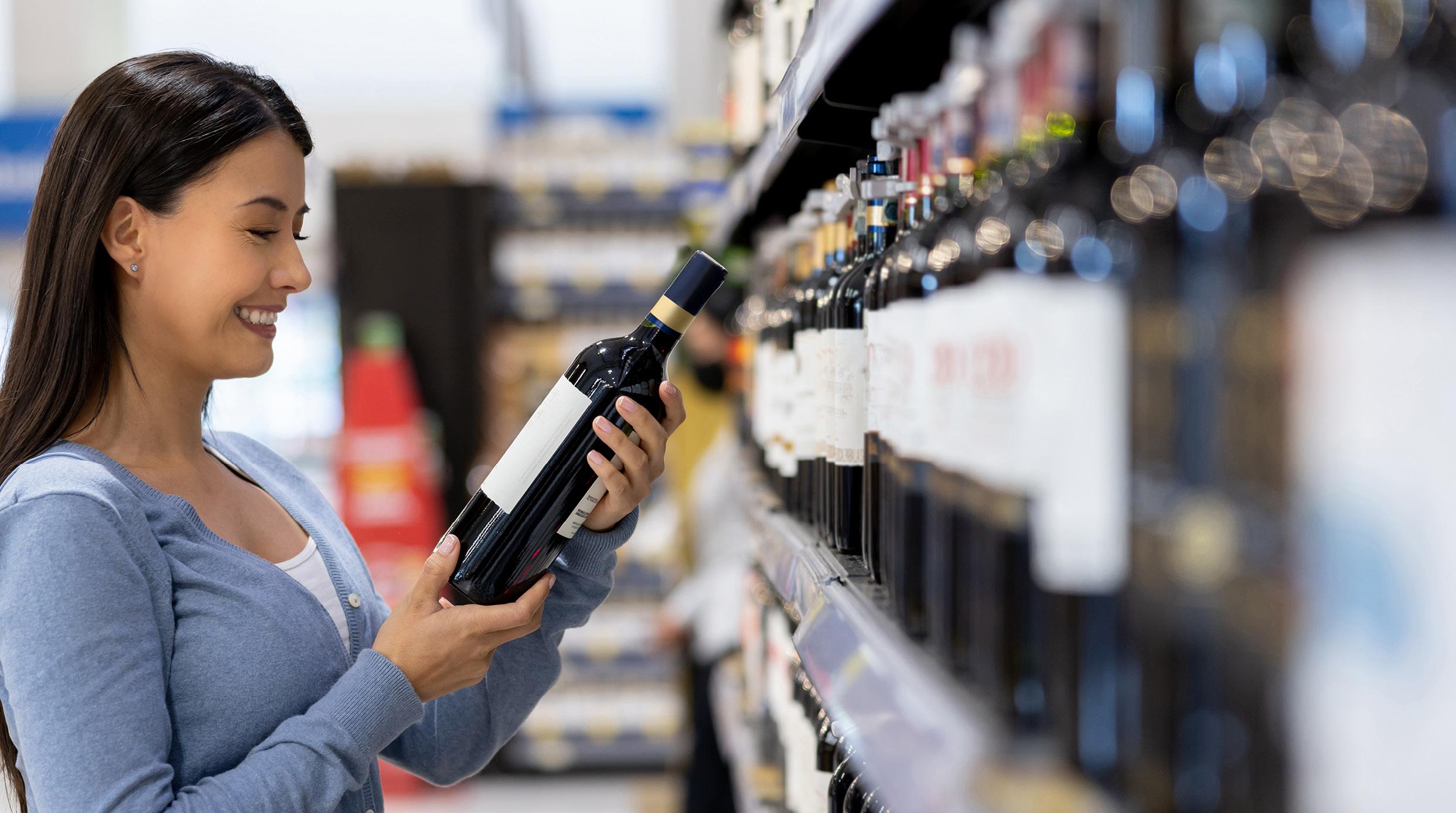
Nevertheless, independent liquor retailers around Australia know it’s important to remain vigilant to respond to the challenges of the market today. One such area that the nation’s banner groups are looking into is how best to approach online shopping. E-commerce has provided a vital lifeline to stores and groups during the darkest period of the lockdown era. But now, there are indications that some e-commerce businesses have suffered as trading conditions changed.

The banner groups in this feature have approached this challenge in diverse ways. But across all groups and any other challenge that arises, one question consistently seeks to be answered - how can banners help give their member stores an edge? During difficult times, it can be reassuring to be part of a larger ‘family’ and have someone in your corner.
In these pages, we hear from the leaders of some of the key banner groups in Australia – Australian Liquor Marketers, Independent Liquor Group, Independent Liquor Retailers, Liquor Barons, Liquor Legends, Liquor Marketing Group and Thirsty Camel Victoria. They share their thoughts on the market and how this has been reflected in their brand’s performance, how trends are making an impact, and how they are developing their strategy this year. ■

Inflation, increased costs and rapid changes to business mix are obstacles that banner groups are overcoming successfully, as Seamus May hears.
Banner group leaders share their thoughts on major trends in the liquor retail sector, and reflect on the ongoing ‘shop local’ movement.

“2023 to date has seen a stabilisation of the market compared with the extreme growth of prior years. The COVID period delivered rapid change in where shoppers preferred to shop and what they purchased. The prior years delivered great growth through premiumisation of products and larger basket sizes, along with shifts in category purchases to RTD and spirits. These trends have stabilised and are being maintained.”
- Gavin Saunders, LMG“The ongoing popularity of low and no-alcohol products continue to rise. We are also seeing a lot of suppliers in all categories introducing smaller pack formats, value packs or focusing on four and six pack formats to soften price shock. ILG has also always been a strong advocate of the ‘support your local’ movement. We are pleased that this has remained strong after the pandemic, and we have continued supporting members involved in their respective neighbourhoods.” -
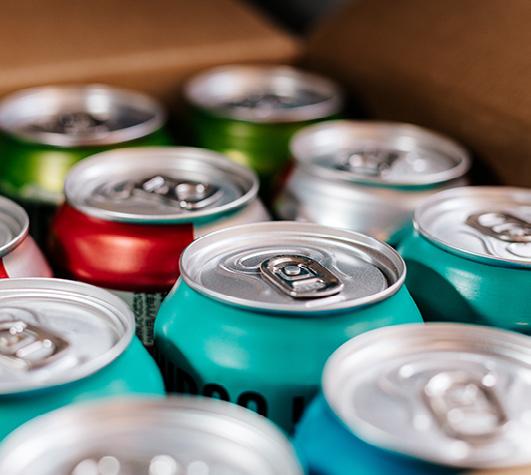 Paul Esposito, ILG
Paul Esposito, ILG
“Familiar brands are resonating well with shoppers, as is the continued category shift towards spirits and in particular RTDs.”
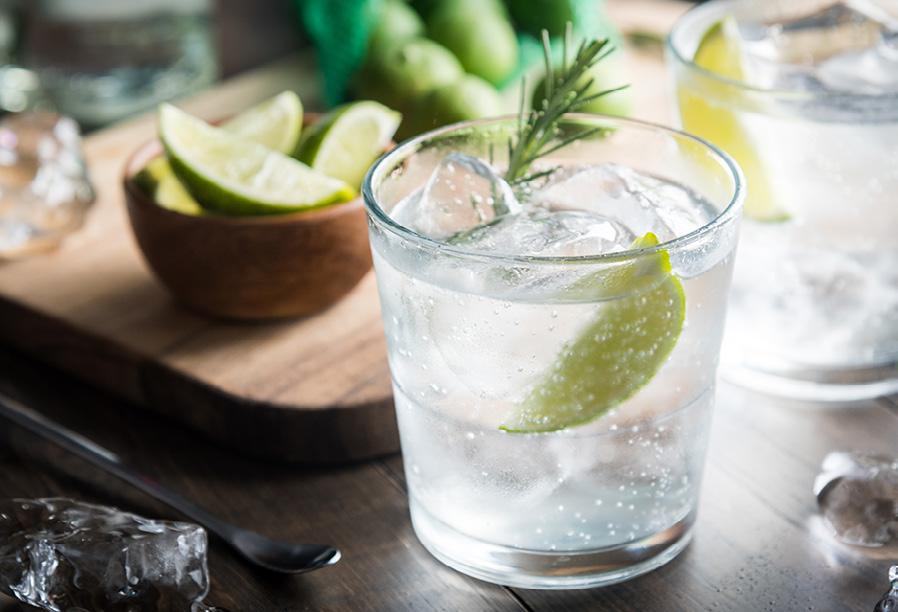 - Vaughan Peters, Liquor Legends
- Vaughan Peters, Liquor Legends
“We’re still seeing some strong growth in the RTD category especially in light RTD. The lemon refreshment category and flavourful vodka mixes are very much on trend. Also seeing growth continue in the ginger beer space and seeing some surprising uplift in wine, especially local sparkling.” - Corey
“Glass spirits continue to grow as people look to continue making drinks at home. Whiskey and vodka are the main drivers of these categories for us. Shopping local remains highly relevant as consumers have discovered that independent businesses can offer competitive prices while also providing exceptional convenience, particularly through the availability of drive-thru bottle shops.”

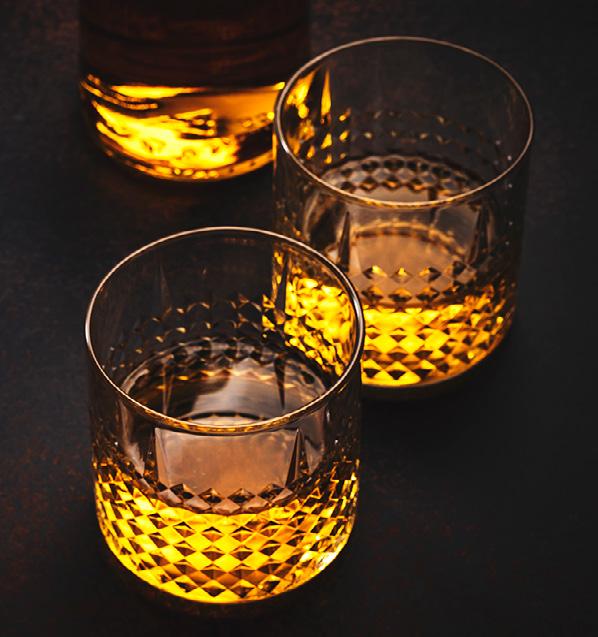 - Adrian Moelands, Thirsty Camel VIC
Leeson, ILR
- Adrian Moelands, Thirsty Camel VIC
Leeson, ILR
“With the substantial increase in pricing seen this year, plus rate rises and more, consumers are seriously feeling the pinch and without giving too much away, our next brand campaign will be responding to this.”
- Chris O’Brien, Liquor Barons“Consumers are increasingly looking for ways to support their local businesses, and independent retailers are well-positioned to capitalise on this trend. We’re also seeing a continued increase in spirits and RTD, as innovation in flavour continues to win new consumers into these categories.” -
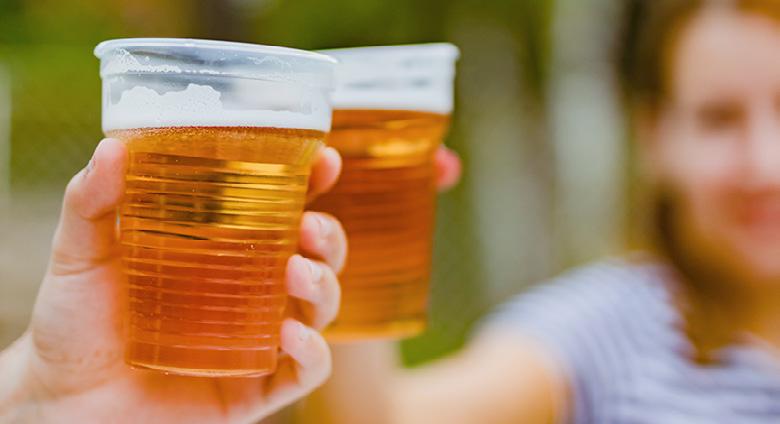 Nathan Rowe, Sessions Liquor Group
Nathan Rowe, Sessions Liquor Group
“CPI increases, interest rate rises, cost of utilities and living have all led to a shopper who is more aware of their wallet… ALM believes shoppers will be looking for value ads across not only liquor but across all retail categories.”
- Chris Baddock, ALMQ: How have things been going for ALM so far this year?
ALM has spent the first half of 2023 continuing to drive our singleminded strategy of ‘famous, frictionless and sticky’. Famous for the right offer and brands, frictionless in the best core processes and sticky in the value creation for retailers and suppliers.
Most recently we launched ALM Connect, a one stop shop for all ALM customers. ALM Connect gives retailers access to products through their existing ordering processes not available in the warehouse, while enabling suppliers to make available their more local, unique, and tailored products to the entire network base. With on average 50 products being onboarded to the site daily, we believe our retailers and on-premise venues will be able to offer exactly what their shoppers/consumers are wanting.
Q: Are there any exciting projects you’ve been working on to support your members?
Further to ALM Connect, the team has been focusing on shifting from pilot to launch of the loyalty program and have most recently launched My Bottle-O Rewards. The pilot has been a success with basket size for loyalty purchases much higher than the average transaction. With demand from retailers to join and sign up to the loyalty program growing across both The Bottle-O and Cellarbrations, it is just another way retailers are rewarding their shoppers and keeping them coming back.
It’s certainly been a busy start of the year and due to launch later this year is ROSS (Retailer One Stop Shop). However, more importantly, One Stop Shop as it will be available to both retailers and on-premise customers. ALM One Stop Shop is a single channel of communication for all ALM customers, from delivery details, new products and marketing campaigns, all tailored to the individual store or venue.
Q: ALM’s award-winning owned and exclusive portfolio is continuing to grow – how important is this for the company?
CPI increases, interest rate rises, cost of utilities and living have all led to a shopper who is more aware of their wallet. This is why we have spent the past few years building our owned and exclusive portfolio, which not only drives a point of difference for our retailers but offers
a range of products giving great margin and very competitive prices for shoppers.
Products like Cougar RTD launched recently in the value bourbon space and POETS beer is one of our fastest growing beers sitting in the value space. And our wine portfolio was recently awarded eight medals at the International Wine Challenge.
Q: Why is now a great time to be part of your group?
ALM believes shoppers will be looking for value adds across not only liquor but across all retail categories. However, for us it is a strong focus on our promotional programs and more importantly our prices locked programs, rewarding shoppers with consistent competitive prices in market on their favourites.
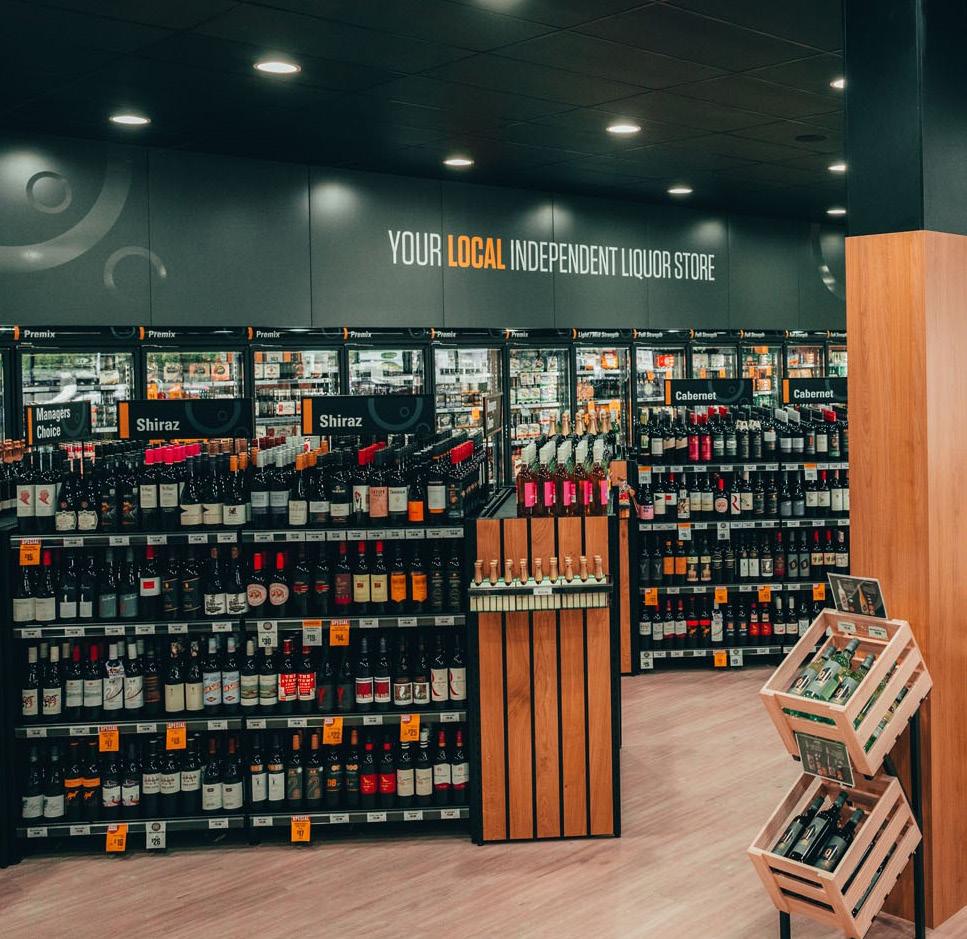

We know the expansion of our loyalty program, e-commerce online exclusive deals and rewarding shoppers with gift cards will continue to drive shoppers into our member stores.
ALM is set to announce our full year results to the market on 26 June. ■
The biggest wholesaler to independently owned liquor retailers in Australia

We want to help you create the best store in your town

1 Through famous brands with unique character
2 By being frictionless from order to cash
3 By building programs, which create growth for you and your shoppers
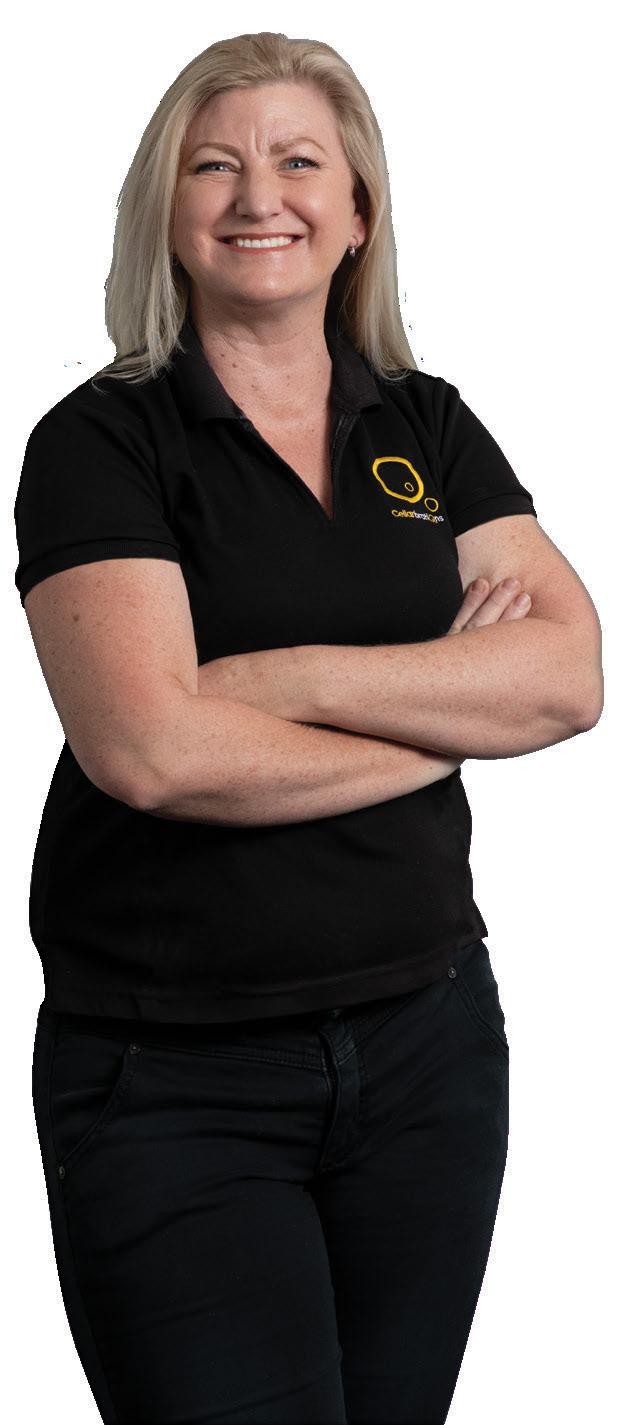

Q: How has your performance been so far this year?
Growth in membership has remained steady and favourable for ILG. The co-operative welcomed over 500 new members to the ILG family from July 2022.
Recent member additions include managed groups which has also increased the number of accounts we service. To ensure we maintain acceptable service levels, we have also grown the ILG staff family with new faces in the areas of IT, trading, finance and supply chain. ILG’s half-year results continue to surge across all channels of the business. Revenue grew by 21 per cent compared to the same period last year, while case sales surged by 14 per cent. Profit surpassed last year’s figures by 21 per cent.
Q: You recently introduced the Liquor Co-op Warehouse and the Liquorstop Warehouse – how has their early performance been?
Liquor Co-op Warehouse is doing well. We have a dedicated person overseeing both platforms of Liquor Co-op Warehouse and the Liquorstop Warehouse. ILG has also partnered with the Restaurant & Catering Association which gives us a wider reach to our target market. This is an avenue allowing businesses out there to access our extensive product range at competitive prices.
Q: How would you assess the success of ILG’s Queensland expansion, and is there any further expansion in the works?
We strongly believe Queensland will surpass NSW in volume and revenue within the next two years. Queensland operates with a different model - we supply brewery products to our members, versus the brewery direct model in NSW. We are in the process of acquiring another warehouse in Queensland to accommodate our growth.
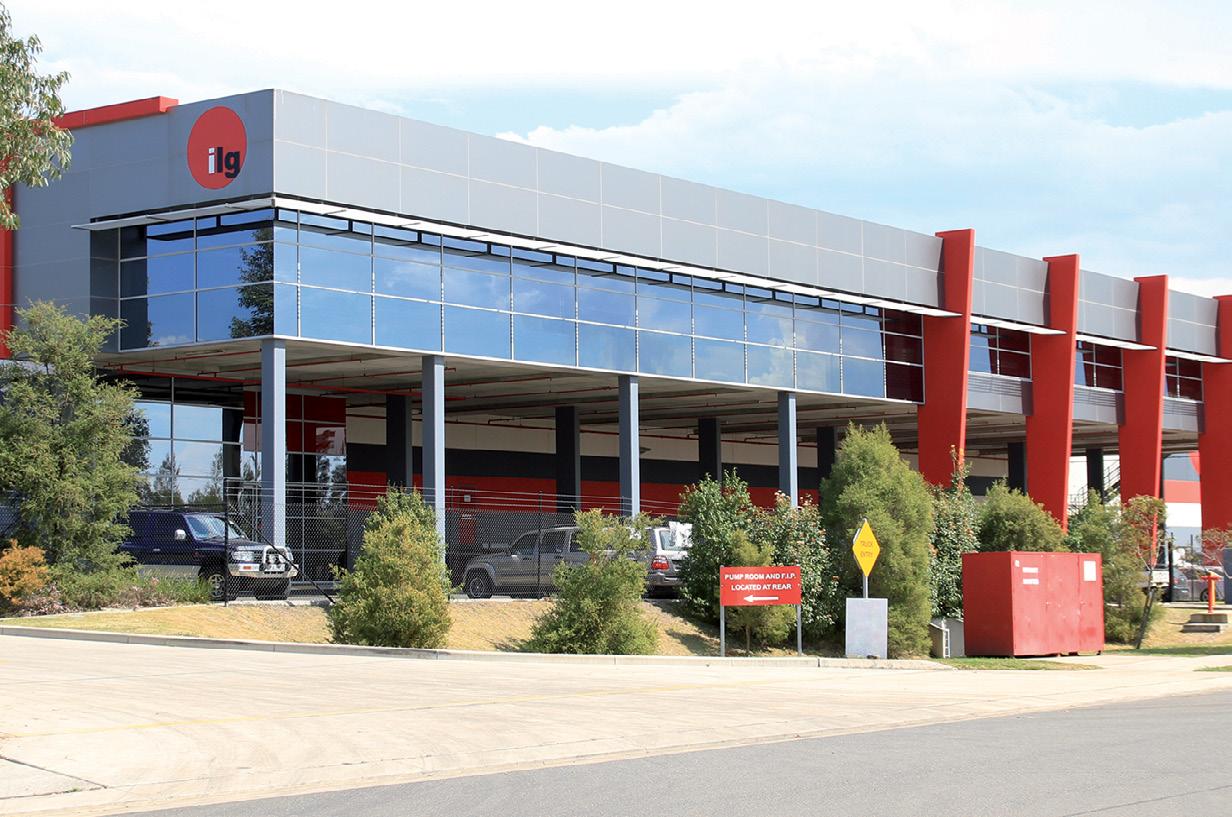
Q: How are you making a difference for your members with current cost pressures?
In the face of fuel price increases, ILG continues to offer its members freight neutral benefits. This simply means that ILG absorbs the cost of transport. That’s one unbeatable member advantage. Membership growth comes with better buying power, allowing
us to pass on the savings to our members, savings they pass on to their customers through better retail prices.
Through our business development training, we continue to support members in enhancing their staff’s skill set, grow commercial knowledge, increase morale, and job satisfaction that breed a confident and reliable workforce.
Q: Why is now a good time to be a part of your group?
As a cooperative, we operate differently. The co-operative is owned by the members, it is not simply trading with ILG – it is partnering with fellow members in collectively shaping the future.
All surplus generated from the provision of its’ service is invested back into the business for the benefit of the members, for example, freight and fuel levies. With costs increasing, we have managed to absorb these increases to benefit our members. For those customers who are not part of the cooperative already, and are feeling these pressures, it’s worthwhile having a chat with us.
ILG’s purpose is to future proof independent retailing. Our membership base is diverse. We supply clubs, pubs, bars, restaurants, stadiums, retail and any other organisation providing alcoholic beverages to consumers. We don’t have the same pressures of return of profits to shareholders as we are not a publicly listed company. Our benefits and cost savings go back to members and the cooperative. Now is the time to join. ■
Pay rebates only on selected Core Ranged products?
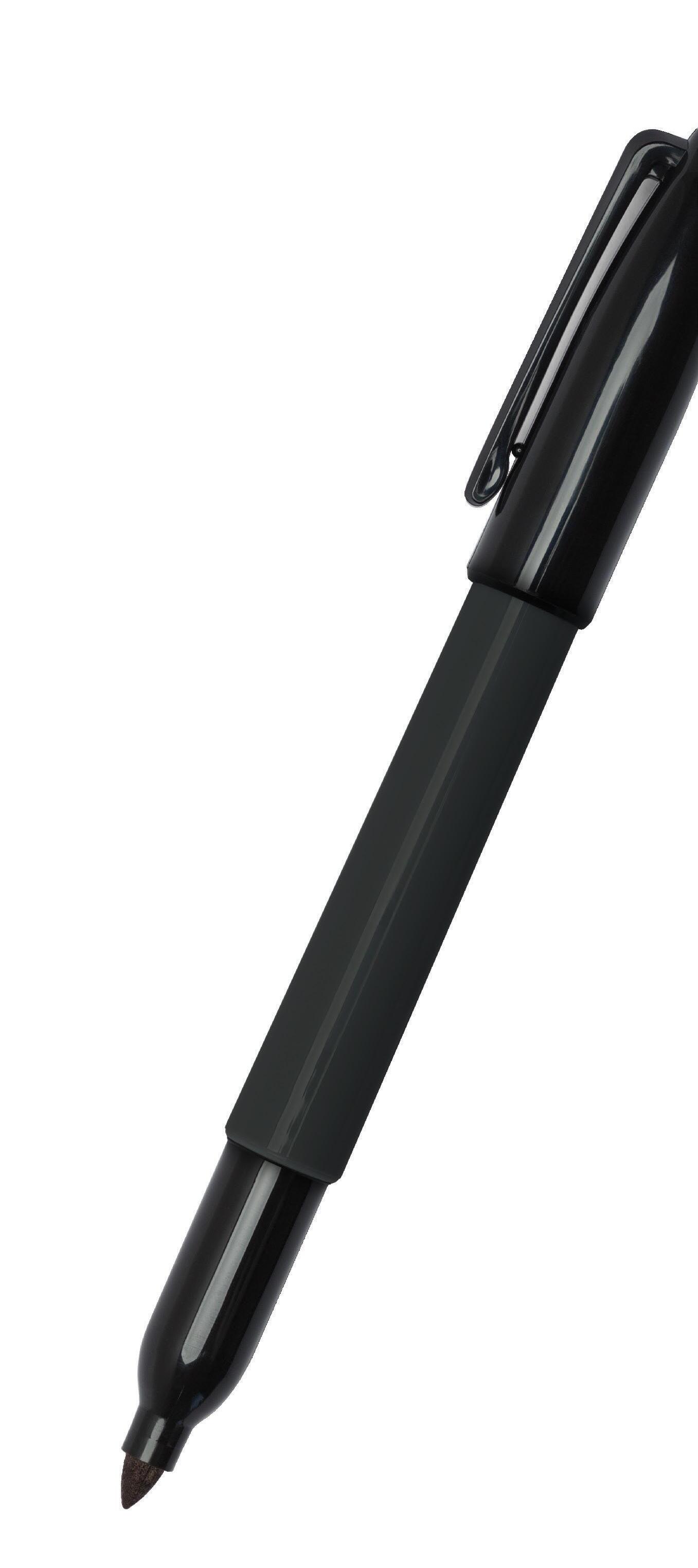
Force you to take product allocations?
Charge you a shrink wrap fee?
Have their call centre or accounts department located offshore?
Make you pay monthly fees?
Include discounts, point of sale and advertising spend in their rebate calculations?
Make you pay for promotional point of sale and signage?
Have agreed terms with all Suppliers?
Have full control of their logistics?
Restrict you from having greater flexibility to retail and market to your local community?
ILG is Australia’s largest member-owned Liquor Co-operative with over $50 million in assets
ILG means ownership in two and soon to be three distribution centres in NSW & QLD
ILG has six strong banner groups providing choice and flexibility to suit your business needs.
ILG has 1500 members/customers strong in three states.
ILG offers competitive rebates on all package liquor purchases with no exclusions.
ILG offers freight rebates of $1.10 per case inc gst
ILG has NO forced product allocations
ILG offers strong signage to improve street presence free of charge
ILG has a dedicated sales team and member services team to help with day to day needs.
ILG has NO shrink wrap fees
ILG offers a marketing and e-commerce platform free of charge including a complete fortnightly printed promotional kit

Q: How has ILR been going so far this year?
We performed above our expectations in the first quarter of this year. A combination of CPI buy-up, solid marketing plans to pull through stock in February and March and then a great buy-up in late March in the lead up to Easter saw great trading results. Our store count has increased in the first quarter due to continued growth in the Queensland market and increasing our presence in Sydney through to the Central Coast. Our Liquor & Co. banner seems to be appealing to these areas as most of the new stores have chosen this banner.
Q: ILR has a focus on local trends through advertising to appeal to consumers in certain areas – how is this tactic faring?
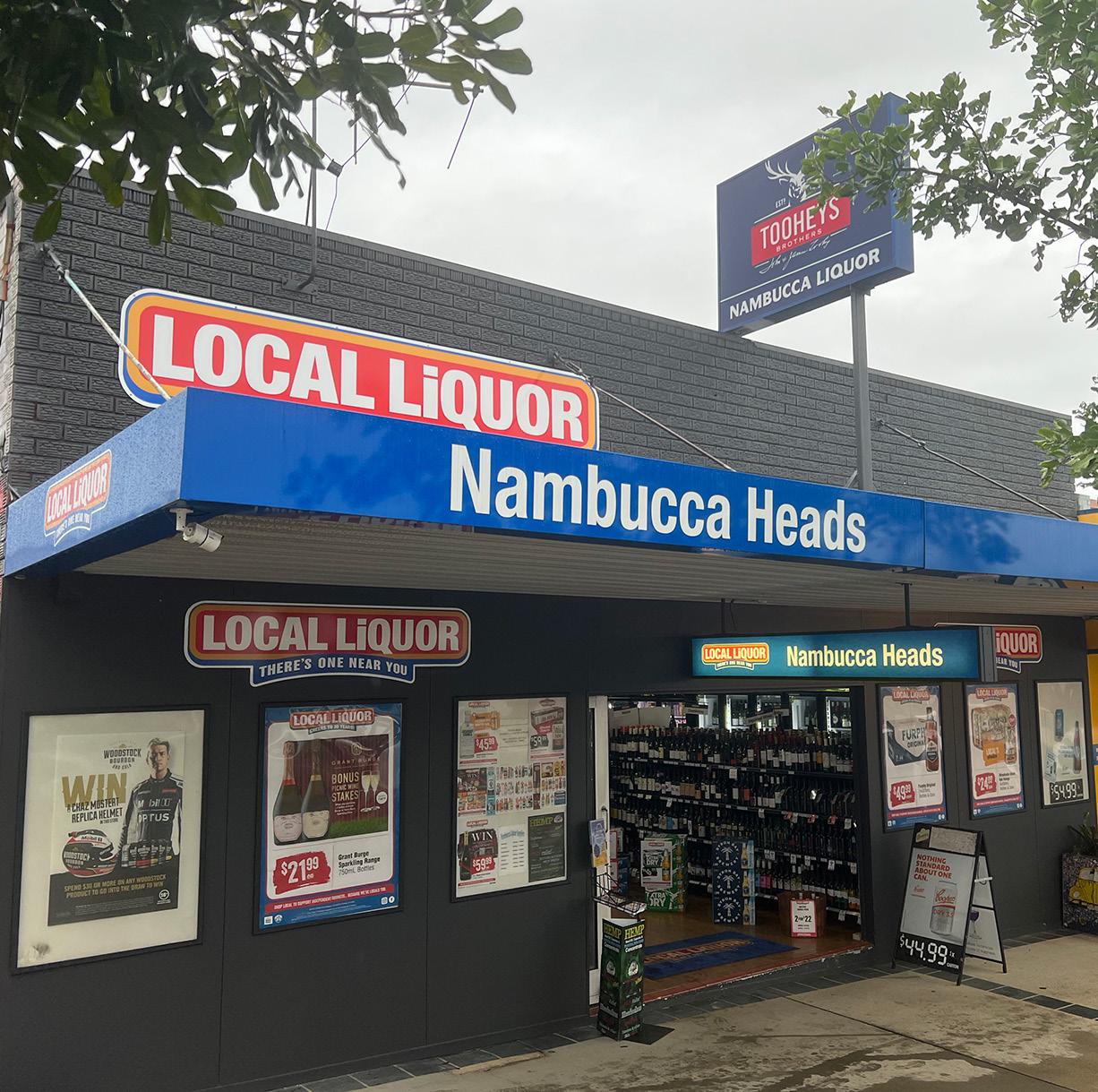
We’re not only varying the products by local region but reviewing product mix to ensure we are providing the right amount of offers in each category based on location. We have seen this used most successfully in the ACT region. We have continued to grow local craft brewers Bentspoke and Capital which combined now have a higher share of business in the ACT than Coopers. Additionally we have added local wines like Collector, Eden Road and Nick O’Leary to our programs and have seen them grow more than double digits. Canberrans and our stores are very much supporting local.
Q: It’s a difficult economic environment for consumers and retailers alike – how are you helping your members navigate this tough terrain?
We have put a lot of focus on helping businesses reduce their costs. We want to be more than just a banner but a business partner that will help in all areas, not just pricing and marketing. We have partnered with Choice Energy to help reduce electricity prices, partnered with merchant service providers to reduce fees, partnered with insurance companies to reduce insurance and improve their level of cover. All things that add up to some significant savings. But the main focus is how we grow our share. Driving consumers to our members stores by showcasing our great offers. Our move to more digital advertising is driving this change. We still have work to do but providing the right offers to the right shoppers in the right locations is starting to prove fruitful.
We are doing a full business review to ensure we set ourselves up for growth and adapt to changes in the market. We’ll be conducting some strategy sessions to understand where we need to be and what we need to do to be successful. We are already seeing the impacts of inflation and rate rises and we need to ensure our business has a plan to navigate this period to support members and grow our market share. We are asking for members’ feedback to get their buy-in and make sure we take them on the journey.
We are a member-driven group and decisions are driven on members’ needs and not shareholders. Being a profit-share business we return all our profit back to our members. We provide flexibility in ranging to tailor to local markets and reward you for execution, not punish you. We are the local. ■

Q: How has your performance been in the first quarter of this year?
Sales and transaction count for the first quarter of this year have both grown on our 2022 and 2021 figures. Given that this quarter we’ve navigated the largest CPI increase seen since the 80s, exceeding last year’s sales figures is an outstanding result. With sales at three per cent above last year, our margin has also grown both in value and percentage points, increasing profitability for our co-operative members. These numbers reflect our customers are remaining loyal in this difficult economic environment.
We’ve seen our store count increase and I don’t see it stopping any time soon. This year alone we’ve had five new stores join our group in the first quarter, with a sixth store planning to open its doors in June 2023. Our focus is not only on increasing our footprint, but on recruiting members that are the right fit.
Q: The Legit Locals campaign was very successful, what’s next for your marketing?
Liquor Barons’ Legit Locals campaign ended in January 2022 and as restrictions eased and our market changed, we went in a new direction for our 2022-23 summer campaign. The campaign ‘Wines, Beers & Independent Spirit’ was born out of communicating our unique selling proposition in a different way to our previous Legit Locals brand campaign.
As WA’s only 100 per cent locally owned and operated independent liquor co-operative with over 60 stores and counting, ‘Independent Spirit’ was and still is at the very core of the Liquor Barons brand. The challenge was communicating what the benefits of being an independent liquor retailer are to our consumer – that we’re not part of any national chain and their cookie cutter offering! The new campaign was a fresh take on showcasing this point of difference to our local WA community.
Q: How are you managing staffing issues?
Having seen a spike in younger members joining the group in 2022, the co-operative was met with a hard decision to restructure the head office team to meet the needs of the growing group. Liquor Barons underwent the restructure in the last quarter of 2022 to make sure we were equipped to meet the changing needs of our co-operative. We
were successful in recruiting a new, entrepreneurial, and energetic head office team to complement our established and experienced employees. Combined, they are kicking goals for the co-operative’s members. We are investing in training and other initiatives to develop their skillsets further to continue to be ahead of the curve and best-in-class in the industry.


Q: How are you helping your members amid economic challenges?
We’ve seen in our sales data that transactions are starting to reduce marginally after the first quarter, however we are growing sales value and we are doing this while successfully hitting required margins. This is because of how we strategically develop ranging and promotional activity for our members and uphold strong relationships in our close supplier network. There is also a lot of focus on managing the logistics of a strained supply chain, not just with globally sourced stock, but the more than 80 per cent of stock which comes to WA from the east coast.
Q: How has Liquor Barons enhanced its capabilities?
Our team is well positioned to navigate the market changes that lie ahead and with great change comes great opportunity. As part of the restructure in 2022, we brought creative talent in-house. Our marketing team is more nimble than ever before and we are being recognised industry-wide for the calibre of what we are delivering. Our in-house capabilities also extend to providing one-on-one support to our members on any of their own marketing endeavours they wish to pursue which means our members have a marketing support network at their fingertips. ■
Liquor Barons is WA’s only liquor co-op, which means we’re 100% independently owned and operated with over 60 store owners who live locally in WA.

 Pictured: Husband & wife duo James and Justine from Liquor Barons Morley
Pictured: Husband & wife duo James and Justine from Liquor Barons Morley

Q: Last year saw significant growth for Liquor Legends, how has the start of this year been for the group?
Yes, we had another incredible year overall for 2022 and obviously conscious of the significant external factors impacting our business. Thankfully we are off to a great start - in 2023 Liquor Legends continues to perform ahead of the total market in all categories. Sales recorded +11 per cent versus LY, driven by strong performance in all categories – beer (+6 per cent), RTD (+17 per cent), spirits (+9 per cent) and wine (+7 per cent). Wholesale performance is also in good growth, up by +10 per cent versus Q3 LY.
Outlet retention and recruitment remains the focus within our team as there is plenty of shifting sands at the moment within acquisitions and ownerships and it’s important that we continue to provide the service levels to current members whilst also offering solutions to retailers looking to improve their own business.

Q: What trends have you noticed in the liquor retail industry lately?
We have seen plenty of macro trends that are relevant to general trade, not just liquor. We acknowledge these within our joint business planning sessions with key supplier partners as we prepare for the next 12 months.
We have seen the loyalty of our shoppers continuing to grow, not just within the rewards program recruitment but the confidence in shopper frequency, due to range, pricing and service. This has been evident with off-promotion sales dominating total share of sales, which ultimately means more profitability.
Q: E-commerce was particularly strong for Liquor Legends last year, does that remain the case as pandemic restrictions have lifted?
E-commerce has been the shiny new toy over the last couple of years and continues to surprise us with evidential insights. We are in a strong position with this platform and it really now has become a complement to the bricks and mortar business.
We’ve seen a recent online activation bring over 14,000 new users to the website, over 3,500 thousand transactions, with an average basket size of $253.
Q: How are you helping your members navigate the difficult economic environment?
Absolutely every business has varying pressures to deal with and we don’t get too ahead of ourselves looking into a crystal ball. What’s important is what we know and see and the ability to be nimble enough to react or adjust. Constant review of our program, member support and staying focused on our strategic objectives that encompasses areas like gross profit, category management, systems and development, communication and winning in retail standards aim to contribute positively.
Understanding the shopper insights is crucial as they seek ‘value proposition’ including quality or pack format, to name a couple changing purchase prompts.
Q: Is there anything you’re working on that you’re particularly excited about?
Most definitely yes, excitingly yes. We have two major projects well underway, which will be groundbreaking as additional support to our members. We will introduce LARA, (Legendary Auto Replenishment App) to deliver greater business efficiency on stock holdings, stock turn, forecasting and budgeting from a business support level. Whilst we nurture and grow our current 760,000 rewards members with ‘Project Swordfish’ that will allow unique customer journey experiences.
The benefit to existing and potential members is truly invaluable, not only with these two projects but complementing a full suite of support to drive their business forward. ■








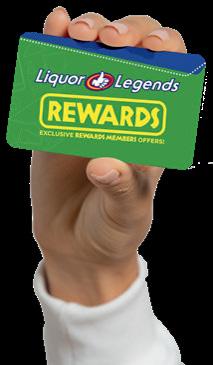







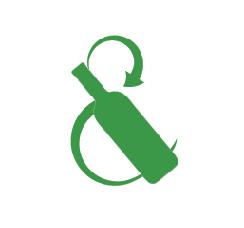





Q: How has your performance been in the first quarter of this year?
LMG member performance for Q1 of 2023 has delivered scan sales growth through our focus on maintaining customer count. Customer count is now the critical gauge of performance for all retailers given the recent record CPI price.
Retailers who maintain strong consumer connection through marketing, retail standards and service will win. The first quarter of calendar year 2023 saw a slowdown in growth compared to prior years, but it’s pleasing to see that like for like customer count grew and therefore sales growth was achieved.
LMG has enjoyed growth significantly above market for three years during the COVID period and an extended period before that, which now totals 25 consecutive quarters (greater than six years) of growth. This is a testament to winning through focusing on the customer.
Q: You recently rolled out new apps for Bottlemart and Sip‘n Save. How has the early performance of these been? Refreshed apps and online sites for Bottlemart, Sip’n Save and Harry Brown provided an enhanced ‘digital store’ offer for LMG members. We know from customer data and industry insights, that online is growing in importance for both delivery and click and collect fulfillment.
Pre-store research for bricks and mortar stores remains critically important. The refreshed sites have doubled visitation to digital stores and deliver greater insight into shopper behaviour.
Q: In 2022, LMG acquired Zen Global – how has acquisition benefited LMG’s loyalty program and data management?
The Zen acquisition provides LMG members a platform to roll out loyalty and data collection which will enhance marketing, while also increasing the efficiency of the campaigns. Migration and further development of the Zen platform has been undertaken with loyalty trial venues planned for H2 of 2023.
Q: How are you working with members to engage your local communities? Have you had any particular successes?
LMG members are integral parts of the local communities through both retail and on-premise. LMG supports retailers to meet their
local market by showcasing products and offers through e-commerce and social and digital marketing, where promotions are geo-targeted down to a few kilometres around a store.
Local community engagement is also supported through our marketing programs with local sponsorships and campaigns which are curated for regional levels. A good example of this is the Bottlemart campaign which is run in Tamworth through the Country music festival.

Q: Why is now a good time to be a part of your group? LMG is the only independent banner with no outside equity. We have a sole focus on our members, with all funds devoted to driving members sales growth with the platform for growth, including: e-commerce, loyalty, store design and enhancements, data and insights, retail teams, comprehensive marketing, social and digital, and price investment. With national scale and over $1.5 billion PA in volumes, LMG is uniquely positioned to be focused on members business performance and the resources and negotiating leverage to deliver.
It is a privilege to support our members tackle these challenges and alleviate the pressure by growing the top line sales result. The past few years have shown that good independent retail programs can compete and win through the benefits of being local and the power of banner group.
We welcome all independent members enquiries from those who want a true partner to support them compete and grow their operations. ■












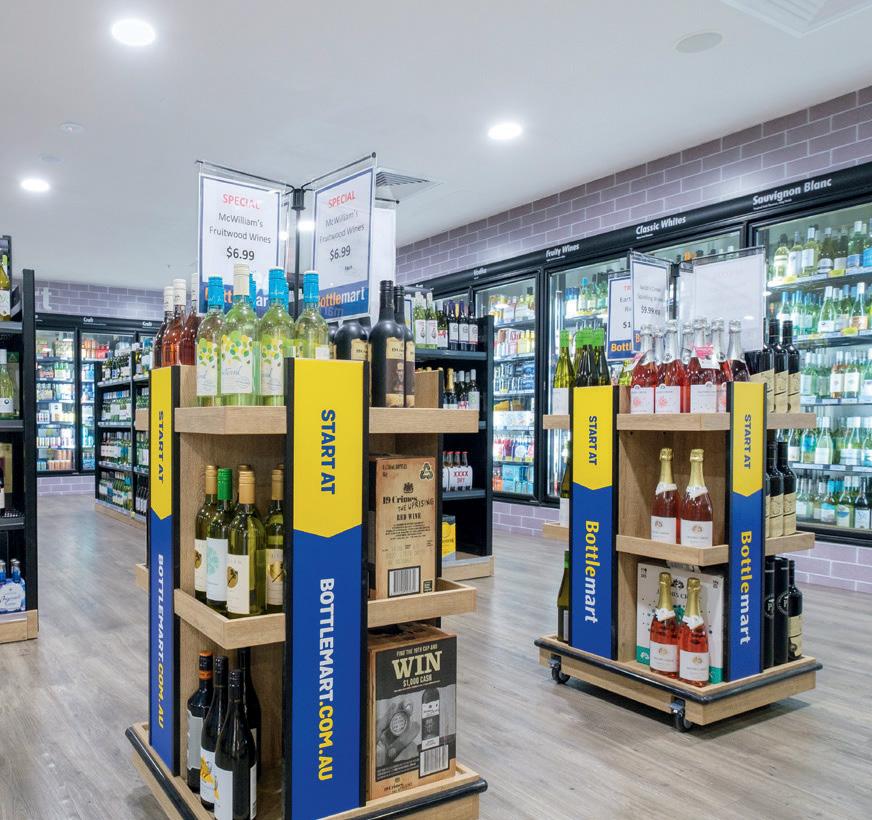
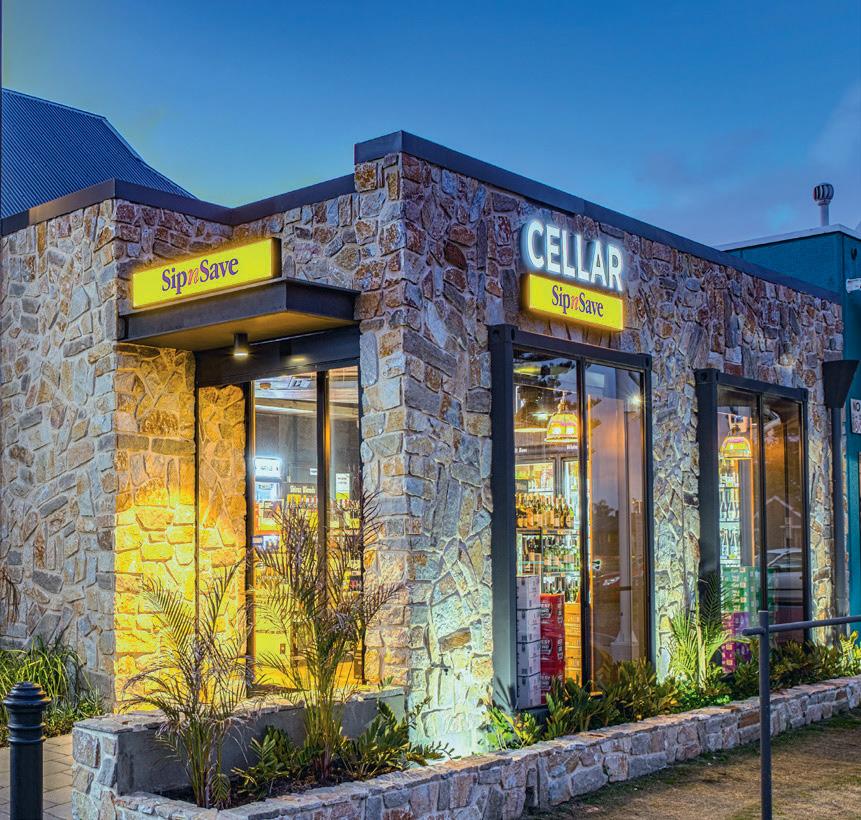

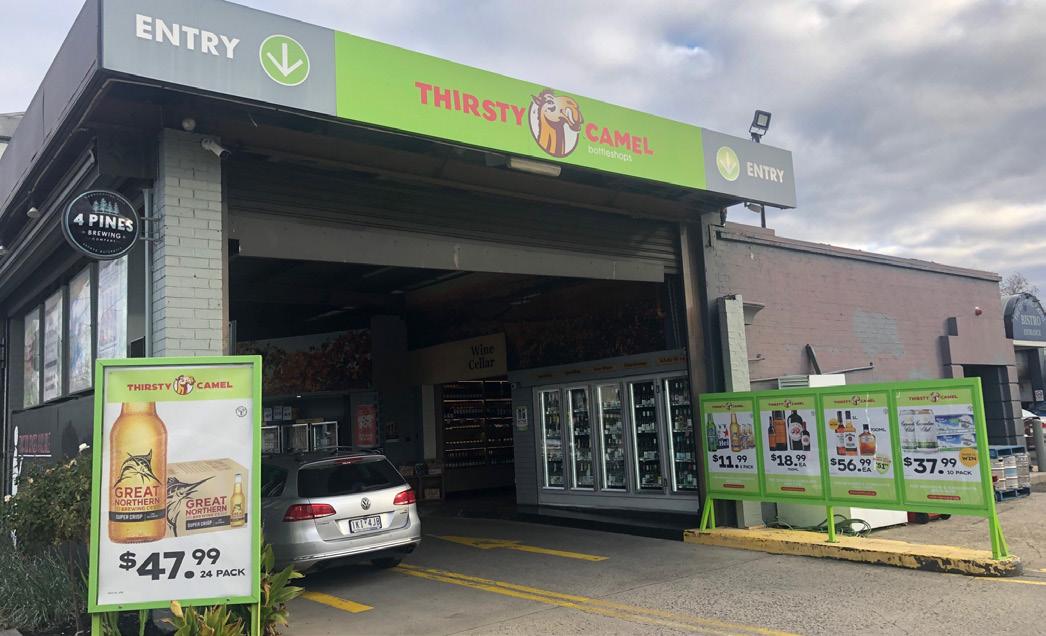

Q: How has your group’s performance been so far this year?
It’s been a strong start to the first quarter. To cycle and grow on the last three years’ performance is a wonderful achievement. We’re driven by our current members and adding the right stores in optimal locations to continue to grow the Thirsty Camel footprint.
Q: How have your tiered model and loyalty improvement projects been going?
The tiered model has allowed the introduction of a wider range of products across our portfolio. Remarkably, amidst this growth, we have remained steadfast in fulfilling our commitments to our valued partners. Over the past year, we have witnessed remarkable progress and advancements, particularly with our Hump Club loyalty program. Through a series of enhancements and innovations, we have experienced a staggering 3.9-fold increase in the number of unique customers per month. The loyalty platform has facilitated a four-fold surge in individual transactions, showcasing the effectiveness of our loyalty initiatives. Encouraged by this success, we are determined to amplify the value of this program for our extensive store network, suppliers, and most importantly, our loyal customers.
As we look ahead, our plans include further enriching the Hump Club experience to ensure it continues to deliver substantial benefits to all stakeholders involved. By leveraging the power of this program, we aim to strengthen the connection between our store network and customers, while fostering mutually beneficial partnerships with our suppliers.
Q: How are you helping your members navigate current economic difficulties?
We are taking significant steps to increase our investment in both marketing and purchasing functions. By doing so, we aim to create a compelling range of offerings that cater to a diverse consumer base, encompassing various price points, varietals, and categories. Our strategic focus lies in ensuring that our members have an enticing selection available in-store to meet the needs and preferences of every customer.
Q: How are you working with members to engage your local communities?
We have increased our regional presence during KSP campaigns through
regional radio partnerships ensuring all our regional markets are capitalising on the peak selling periods. Many of our regional members have a strong connection with the local sporting clubs and associations and we will continue to encourage and foster these relationships.
Q: Is there anything you’re working on that you’re particularly excited about?
We are excited for our two upcoming business conferences that will provide exceptional opportunities for our community. First, we have our conference in Malta, scheduled for June. This event will bring together a diverse gathering of 130 members and suppliers from various industries. Following on from that we will have our local forum in Hobart, set to take place in September. This event promises to be our largest gathering yet, with over 300 members and suppliers. As our members come together, they will have the unique opportunity to delve deeper into our shared objectives and strategies. These annual member engagement conferences stand as testament to our commitment to nurturing a thriving community of professionals.
Q: Why is now a good time to be a part of your group?
The prevalence of convenience shopping remains steadfast, and our program and consumer offering play a pivotal role in this domain. As the demand for convenient shopping experiences continues to grow, we have strategically positioned ourselves to meet the evolving needs of consumers. We are dedicated to continually enhancing our program and offerings to ensure that we remain at the forefront of meeting the convenience-driven preferences of our valued customers. ■
LAUNCHED BY A SPONTANEOUS BUNCH OF PUBLICANS NEARLY 15 YEARS AGO, THIRSTY CAMEL HAS BECOME ONE OF AUSTRALIA’S MOST RECOGNISED INDEPENDENT RETAIL BRANDS; WE’RE THE LOVABLE MAVERICK OF THE LIQUOR WORLD, AND PROUD OF IT.

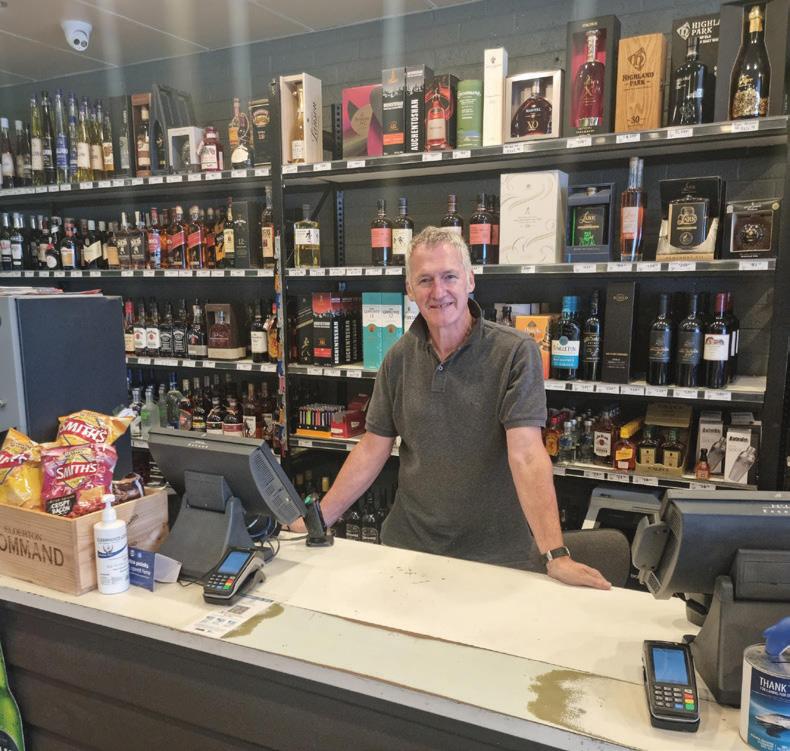
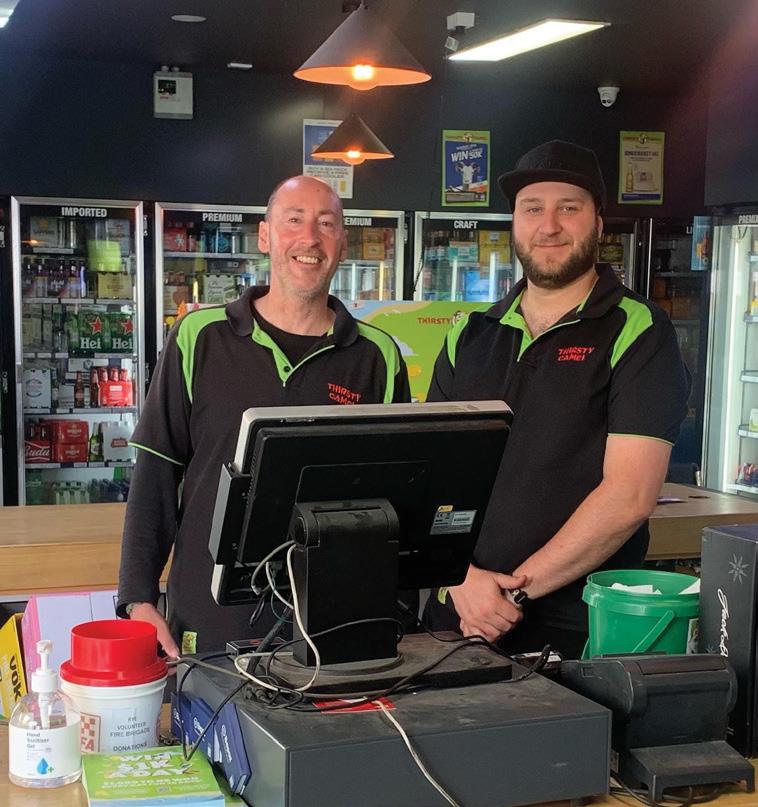
350 Thirsty Camel stores dotted across the country.
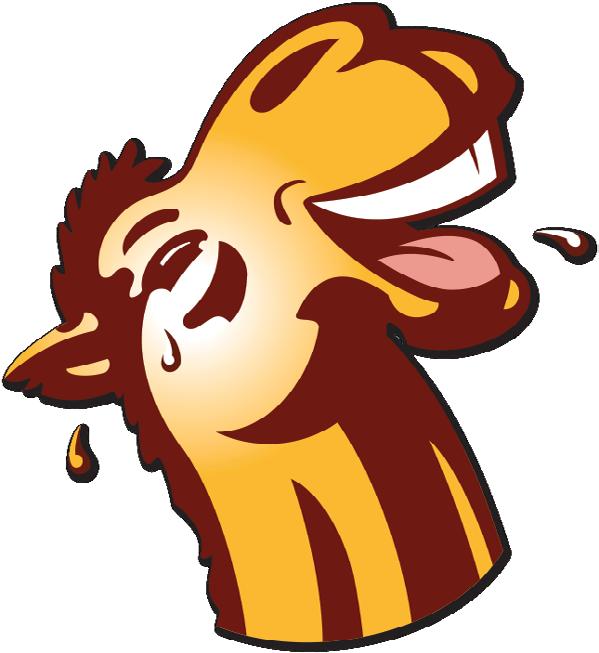
The best in drive through convenience.
State specific loyalty programs to drive retention and repeat purchase.
Insight driven marketing campaigns all year round.
A succinct core range of products allows venues to work with supply partners to accommodate their local needs and customer base, utilising data driven insights and trends our core range covers all categories delivering strong margins and profitability.
State based opt in programs including a Craft Beer and Premium Spirits program allow flexibility to work with global leading brands and up and coming local products to reflect current trends.
Q: How has your performance been in the first quarter of this year?
We’ve had a strong start to the year, with sales up 20 per cent in the first quarter for Sessions. We’ve also increased our member count by 13 per cent. We have a really big 12 months lined up for the Paramount Retail department, looking to double our store count over the course of the year ahead.
Q: How are you helping your members navigate difficult economic circumstances?
We understand that the current economic environment is challenging for both consumers and retailers. That’s why we’re committed to providing our members with the support they need to succeed. We offer a variety of resources and programs to help our members manage their costs, improve their digital marketing, and grow the profitability of their businesses.
We’re also working to develop new initiatives to help our members thrive in the current economic climate, including the imminent launch of our Sessions e-commerce stores for each of our retailers, as well as the launch of our Sessions customer loyalty program.
Q: How are you working with members to engage your local communities?
We’re committed to being active members of our local communities. We work heavily with our suppliers to ensure they are being active in our Sessions stores with in-store tastings, events and promotions that bring people together. We’ve had a lot of success with these initiatives, and we’ve seen a real positive impact on our Sessions stores and also our communities.
Q: How is the Sessions app progressing and what can we expect from the finished product?
The Sessions app is at the final stages of testing before deployment to market, so we’re making good progress. We’re excited about the potential of the app to provide Sessions customers with a new and convenient way to shop and connect with our brand. The app will allow customers to browse product selection in each of our stores, place orders for click & collect or delivery, and reap the rewards of
participating in our Sessions loyalty program. It will also provide members with access to exclusive deals and promotions. We expect to launch the app in the coming months.
Q: Why is now a good time to be a part of your group?
There are many reasons why now is a good time to be a part of the Sessions group. We’re a growing and successful brand with a strong track record of success for retailers looking to take that ‘step up’ into a more premium banner group. We offer our members a variety of benefits, including:
• Strong digital marketing and promotional support.
• A purpose-built loyalty program with exclusive deals for customers.
• Best-in-class POS system, e-commerce website and customer app.
• Access to unique promotions and attractive rebates.
• A wide selection of products at competitive prices. If you’re looking for a liquor retailer that can help you navigate the challenges of the current liquor retail landscape, we invite you to learn more about our group.

Q: Any other messages?
We’re excited about the future of the Sessions group, and we’re confident that we can continue to grow and succeed in the years to come. We’re grateful for the support of our members, and we’re committed to providing them with the best possible commercial outcome for their business. We’ve also got massive plans for Paramount Retail in FY24, so watch this space! ■

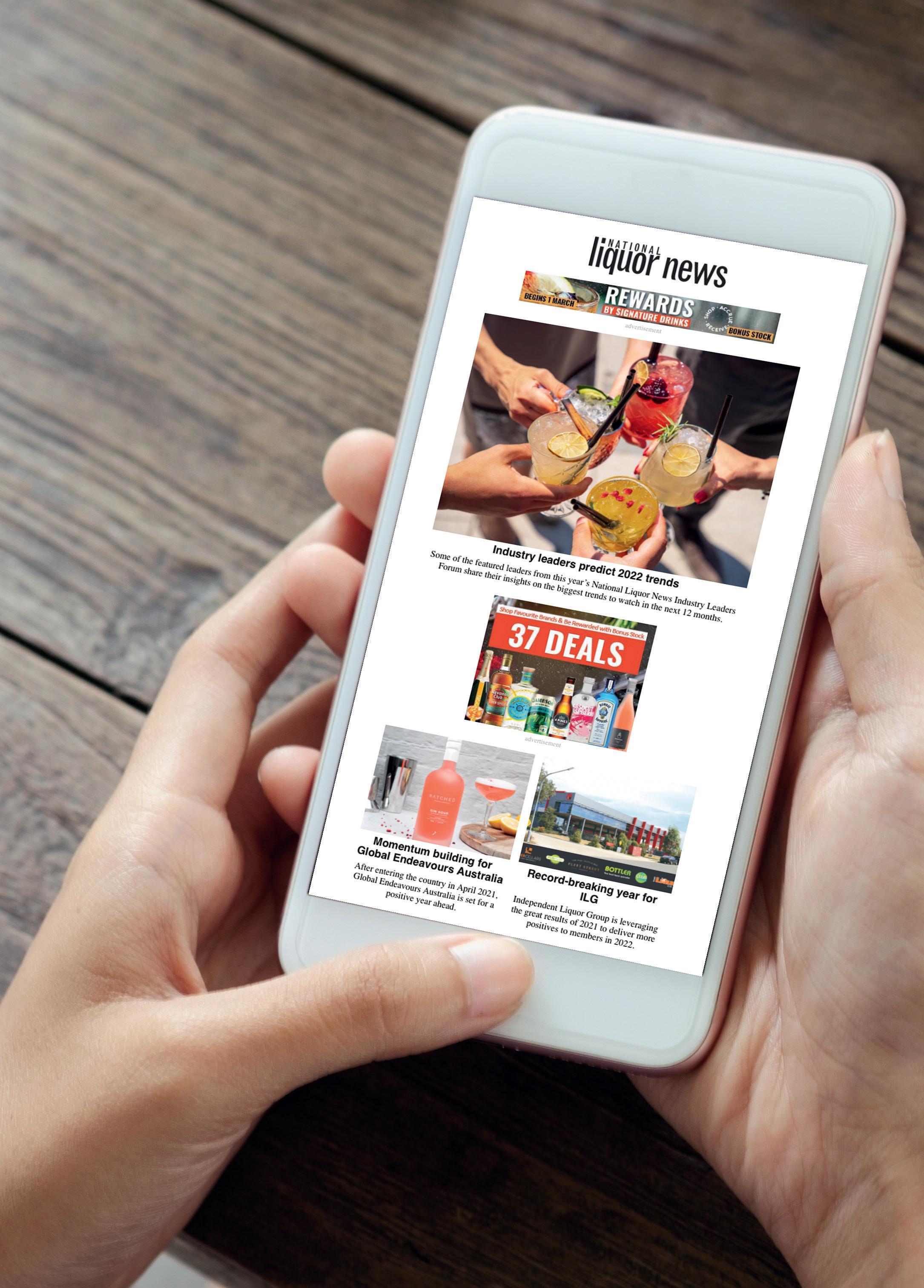


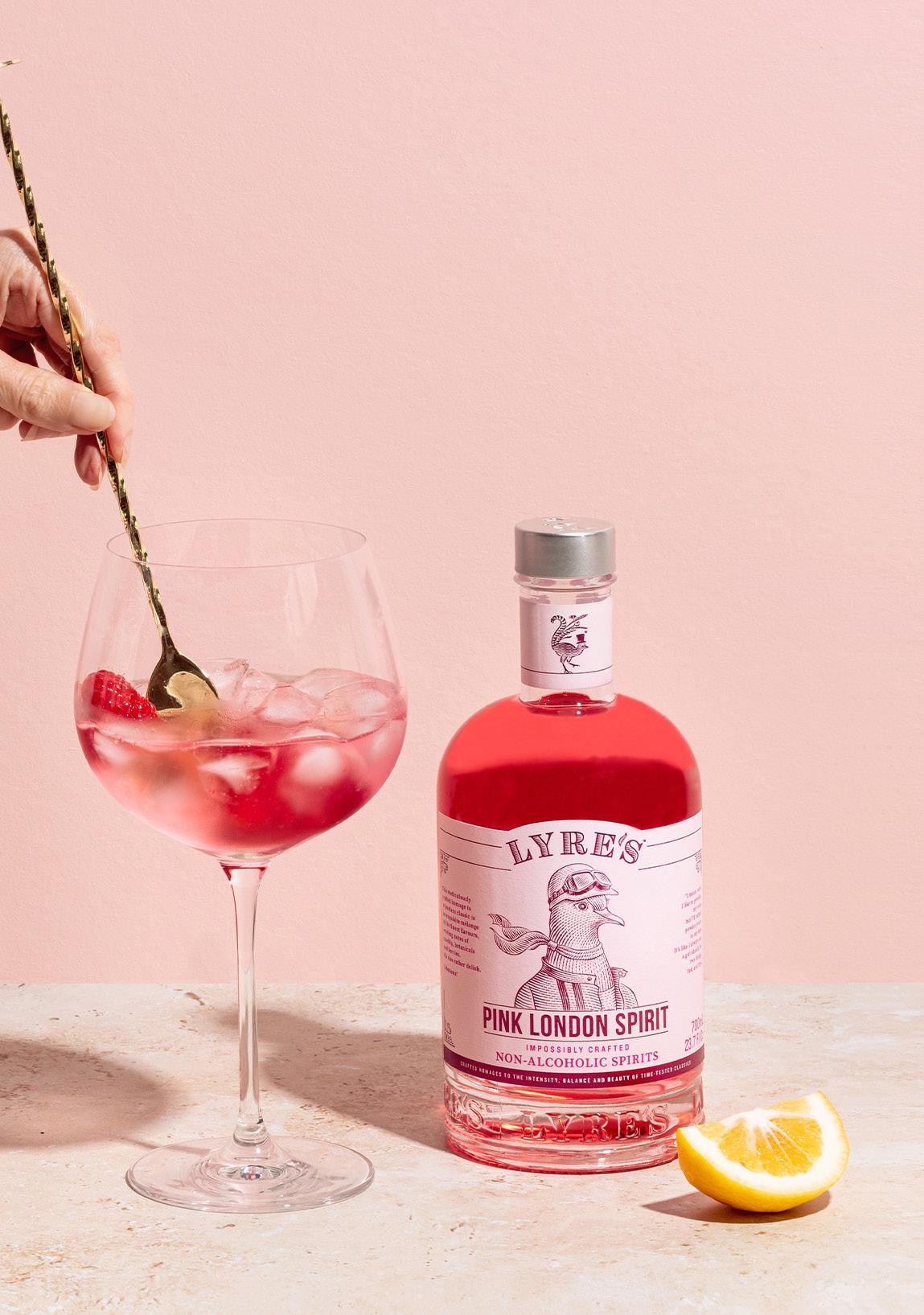

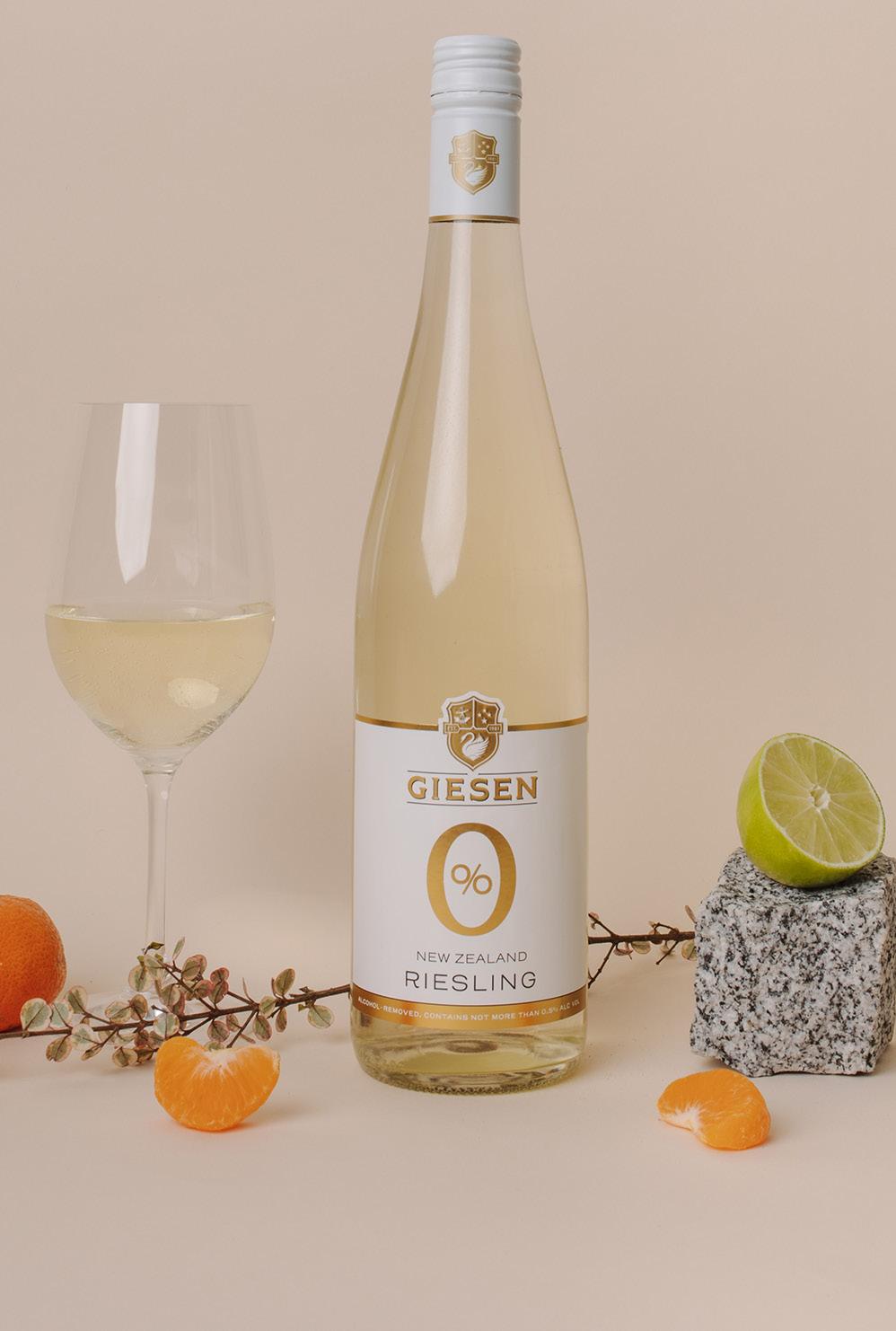
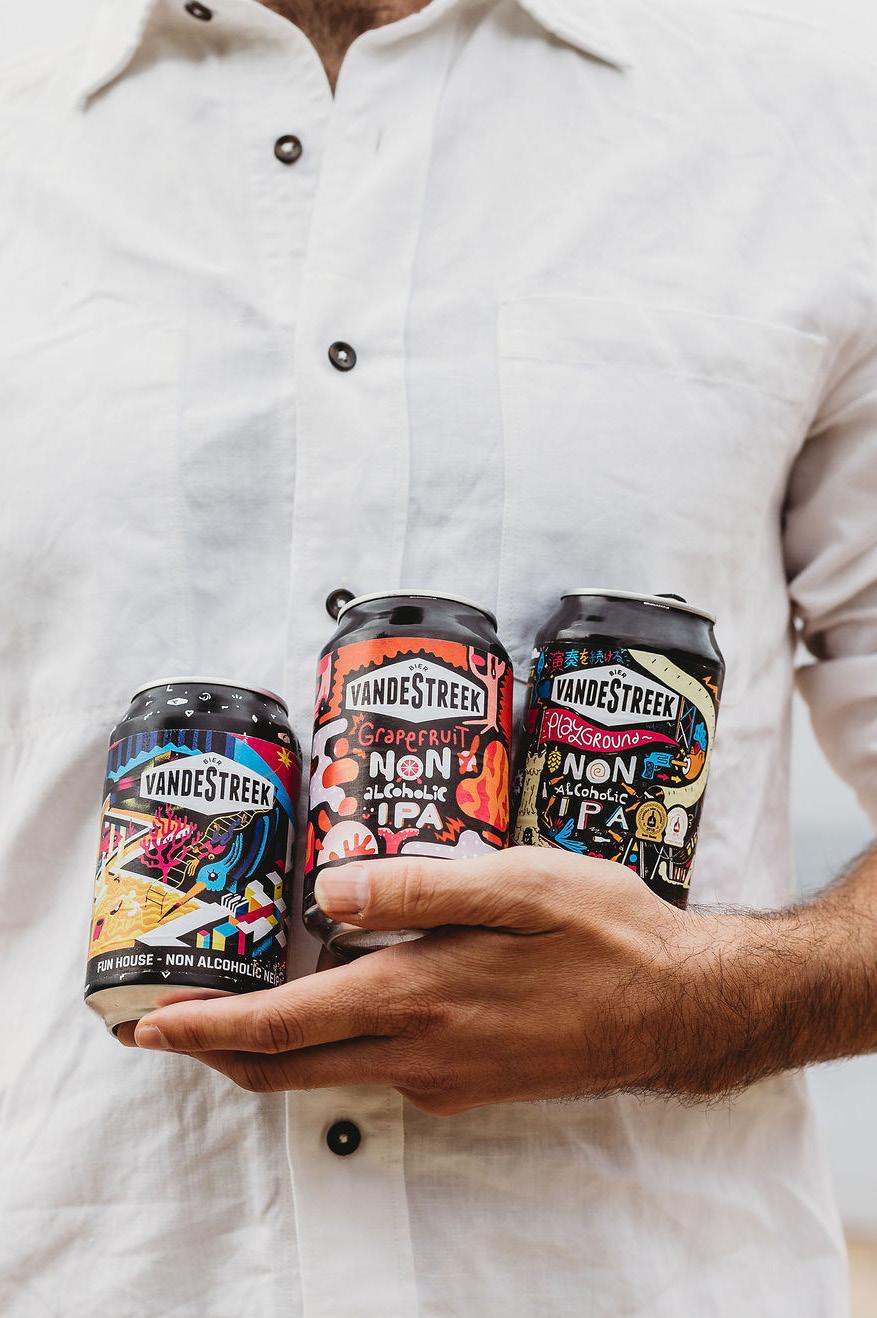
Demand for non-alcoholic options is on the rise with Dry July on the way, and as economic downturns lead more people to choose to drink at home, the off-premise is well-positioned to capitalise on the still-growing interest in no and low alcohol (NOLO) drinks.
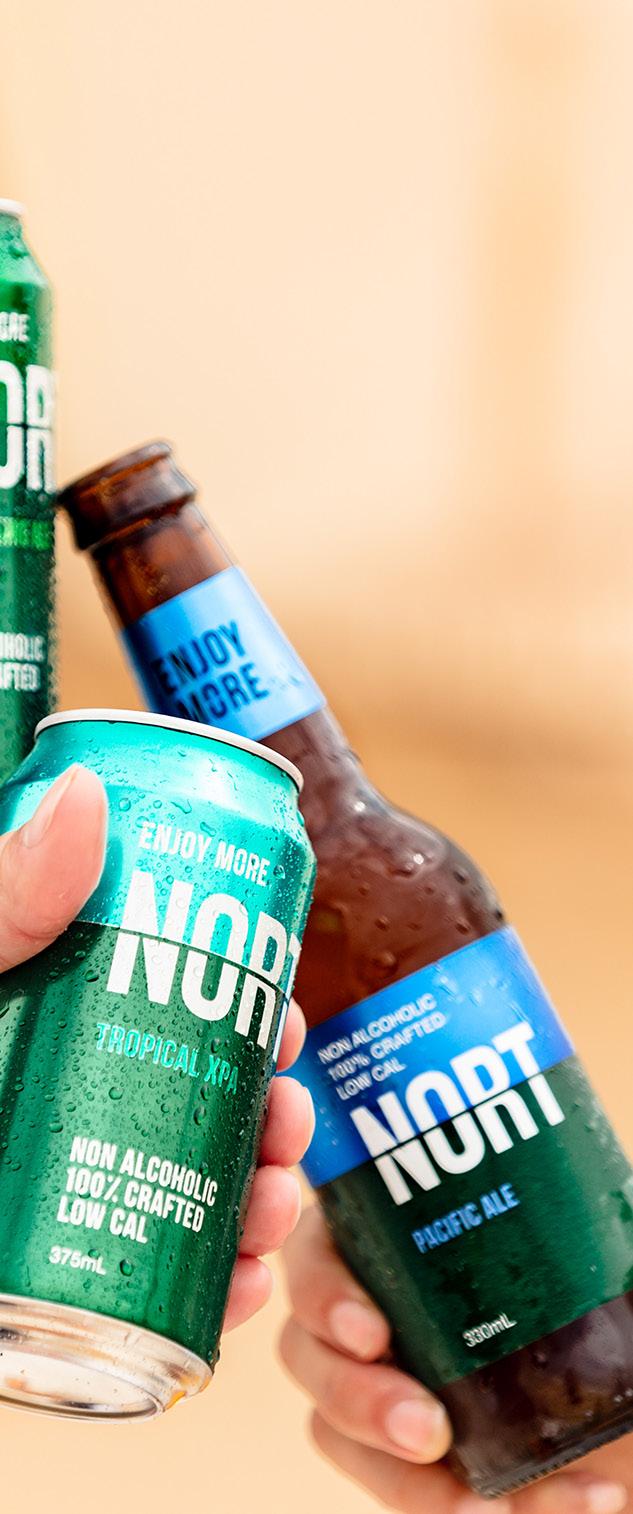
The NOLO sector is a significant part of the drinks industry, worth over US$11 billion internationally according to IWSR, with nonalcoholic drinks constituting 70 per cent of sales in this sector. The growth is strongest among younger generations, who are drinking less alcohol on average than previous generations. They are also the most likely to adopt non-alcoholic beverages, with a DrinkWise study indicating that Australians aged Australians aged 18-44 are twice as likely to consume zero and low strength alcohol compared with those aged over 45.
Albertus Lombard, James Squire Brand Director, gave some further context, and said: “The perception of non-alcoholic or low alcohol has changed considerably and is now seen as the opportunity to have a beer without the effects of alcohol, especially in the interest of keeping social occasions such as catching up with friends or going to the pub.”
Overwhelmingly, non-alcoholic beverages are being consumed by people moderating their alcohol intake, rather than eliminating it altogether. IWSR indicates that this makes up 78 per cent of consumers in the sector.
That’s what has been seen at Heaps Normal, with CEO and Co-founder, Andy Miller, noting: “We certainly hear a lot of anecdotal evidence
from our community that they like to incorporate Heaps Normal beers into their consumption – not necessarily completely cutting out alcohol but being more mindful about how they find ‘new normals’ that work for them.”


For David Andrew, Founder of Naked Life, this has been a shift over time. When the brand started, it had a primary focus towards specific groups of non-drinkers, such as pregnant people, the health conscious, and sober people.
“What we are really finding is, it’s not necessarily just for those specific people. We’re really finding that it’s people that want choice… we’ve got a bigger market and people who drink but every now and then drink some of ours too, as a change up, as part of their night out or sometimes on nights when they won’t drink at all,” Andrew commented.
According to Kirsten Storey, Director of Storeywood Distributors, Europe is ahead of Australia in terms of cultural acceptance of NOLO drinks. This has been compounded by the pandemic, which coincided with the increased interest in NOLO options in Australia, resulting in a delayed adoption of non-alcoholic drinks in the on-premise.
However, Australia is well ahead of other areas in this regard, and Australian production is, unsurprisingly, ahead of the game. Adrien Allier, Owner of Perth non-alcoholic retailer Free Spirit Co, says 70 to 75 per cent of the products he stocks are from Australian brands.
An IWSR report on product development in the NOLO category indicated that trends in the broader spirits category flow over into consumer demand
The no and low alcohol sector is jumping from strength to strength, with no signs of slowing down. Caoimhe Hanrahan-Lawrence investigates.

Alcohol is one important element that helps create the taste of traditional spirits, so non-alcoholic producers need to get creative when replicating or developing alternatives to each flavour.
Martin notes that this makes it just as much a craft to develop a satisfying non-alcoholic spirit.
“On a chemical level, [alcohol] plays a really important role in maintaining flavours or amplifying flavour. It preserves the base notes, it helps with the mouthfeel,” he said.
For Lyre’s, the crafting process begins with identifying the core aromas, tastes, and visual appearance of classic spirits. These elements are replicated by essences, extracts and distillates, which are then added into Lyre’s unique base liquid
“Each of our unique variants in the range of non-alcoholic captures the time-tested style of the classics,” said Bloomfield.
for no and low products, especially those with zero alcohol. The increased interest in aperitif, tequila and RTDs has resulted in demand for non-alcoholic versions.
Sam Manning, Founder of Monday Distillery said: “For a long time, premix and RTDs were seen as the poorer version of the craft that is spirit. Whereas I think there’s this real drive for convenience, and people being able to throw something in the esky and crack it open and enjoy it.”
When discussing the future of the sector, many producers said they expect the number of products to reduce in size but increase in quality.
“It’s consolidating now to people focusing on quality. It’s not just about trying everything that’s out there,” said Storey.
Tyler Martin, Founder of Yes You Can Drinks, believes that the sector will establish itself as distinct from adjacent categories of alcohol and soft drink.
“The non-alc space is small and growing, and we think that it’s going to carve itself out. Where soft drink and alcohol were, two absolutely mega categories, nonalc will sit in between. We think that non-alc sits closer to alcohol, but actually gets adopters from both,” he described.

Abstinence occasions like Dry July and OcSober are key periods of visibility for the NOLO sector, as they are often peak times when people are searching for and being introduced to non-alcoholic beverages.
Giesen Group’s Director of Winemaking, Duncan Shoulder, explained that a 2019 company-wide wellbeing initiative was the inspiration for the creation of Giesen’s non-alcoholic range.
“The winemaking team had a sudden realisation that that meant they couldn’t drink wine for a month, which was bad news. We set about going to the grocery stores and the wine supply shops, trying to find zero alcohol wine… and we weren’t too excited by what we saw,” he said.
“So, we said ‘Let’s try to make one.’ That coincided with the technology becoming available in New Zealand to make dealcoholised wine and so we put a trial together. We were very excited with the product that we made, and the rest is history.”
Retailers and producers report that sales of non-alcoholic drinks start to increase from mid-June. Irene Falcone, Founder of non-alcoholic retailer Sans Drinks, said that her sales following that in July are almost four times larger than other months. However, they don’t necessarily dry up after the end of July, as customers continue to enjoy non-alcoholic products in their daily lives.
“They’ll drop back in August, but they won’t drop to the levels that we were in May. What that means is there’s people coming in to do Dry July and they feel fantastic, and they’ve discovered some of the range,” Falcone explained.
The prominence of these abstinence events has had an important social impact as well, as they have normalised non-alcoholic beverages and abstaining from alcohol in social settings.
Jeff Howlett, Asia Pacific General Manager at Australian Vintage, said: “We are noticing that it’s not just these periods when consumers are opting to abstain from drinking, but rather people are moderating all year-round as it becomes more of an ongoing lifestyle choice. The social stigma of taking time off alcohol has certainly dropped off.”
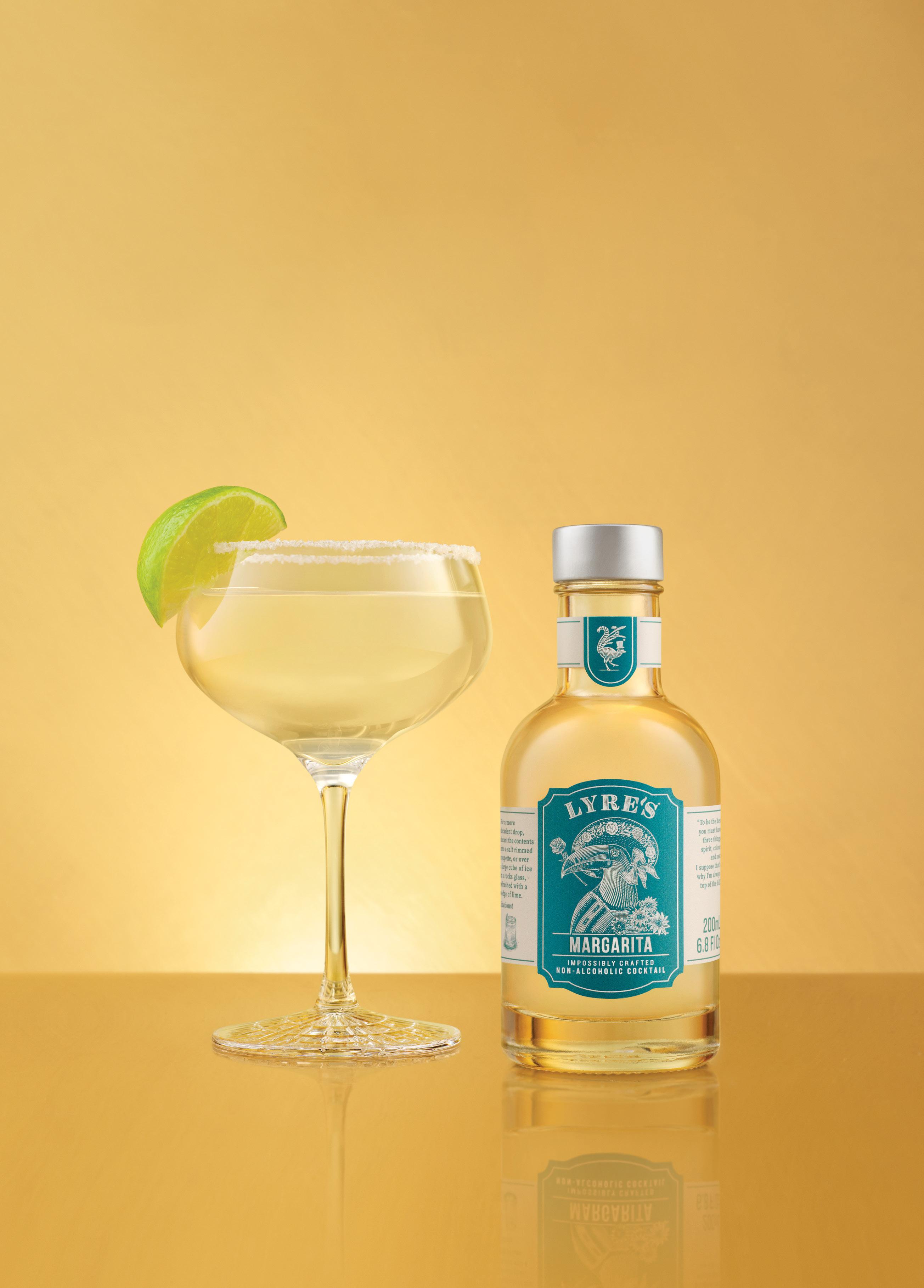
For many of Australia’s leading non-alcoholic beverage producers, the creation of their product came from filling gaps they saw in the market. But in recent years, there is a lot more at play in the market.

Looking at the origin story of the NORT label at Modus is one example. Wearin said her interest in non-alcoholic beer began during her pregnancy in 2018. All she was craving was beer, but she was less than impressed by the non-alcoholic options that were available. Then, it was the COVID lockdowns of 2020 that were the final push she needed to get NORT up and running.

“I witnessed friends, family and customers drinking more, which I knew was not sustainable. I wanted to bring to the market a non-alc beer that tasted like the real thing but without the nasties,” she explained.
Since founding NORT, Wearin has seen the target market shift, with more Modus drinkers also opting for it every now and then, and vice versa.
Kristy Bloomfield, SVP of Global Marketing at Lyre’s, encouraged retailers to not only support these consumer choices, but the occasions driving them.
“Dry occasions are obviously when people are introduced to the category, if you’re doing Dry July, you should be involved in the foundation and support people impacted by cancer,” Bloomfield said.
“It’s much more than just a beefing period for non-alc.”
In recent years, one sector of the market that has seen significant development has been the quality of non-alcoholic wine. According to the University of Adelaide, the global NOLO wine market is growing at more than 25 per cent per year and was worth about $51.6 million in Australia in 2020-21. Fact.MR identified Australia as the most profitable market for non-alcoholic wine.
Even so, the NOLO wine segment is significantly smaller than the rest of the sector. To help address the reasons for this, the University of Adelaide recently opened a world-first wine dealcoholisation research facility, in collaboration with the Australian Wine Research Institute, the SA government, and the SA Department of Primary Industry. The facility allows South Australian producers to dealcoholise trial batches of 50 to 500 litres of wine at negligible cost.
The facility is also undertaking research into dealcoholisation processes and how best to grow and process grapes for dealcoholised wine, as well as educating viticultural students
at the University of Adelaide about the sector.
One area for growth in the field of dealcoholised wine is the development of dry reds. Alcohol greatly impacts the texture and tannin balance of a red wine, and unlike other dealcoholised wine, the addition of grape juice does not correct this flavour loss. Associate Professor Paul R. Grbin, Head Winemaker at the University of Adelaide Department of Wine Science, hopes that the facility has an impact on the quality of dealcoholised wine.
“There’s definitely some research that needs to happen. That goes hand in hand with developing the technology. The ultimate goal is to be able to have a no or low alcohol product that a consumer can’t really tell the difference whether it’s got alcohol or not in it,” Grbin said.
Katherine Brown, fourth generation Winemaker with Brown Family Wine Group, advised winemakers could look to the beer and spirits sector for inspiration.
“I feel that the wine industry needs to keep their eyes open to what beer and spirits are doing. There seems to be a lot more openness and innovation of what’s happening in those other beverage sectors, especially on the international market,” she commented.
Several producers told National Liquor News that non-alcoholic beverages are usually bought in addition to alcoholic beverages, and customers buying both have a larger basket size. This points to the NOLO sector being not a competitor in traditional liquor retail, but a complement.
“Most people that I talk to have had a bad experience with non-alcoholic drinks in the past. People need to know that they need to come back and look at it again, because a lot has changed. It doesn’t all taste like grapefruit juice now, the drinks are getting better and better,” Allier said.

In terms of how to communicate this in-store, one piece of advice from Howlett is to create dedicated non-alcoholic zones.
“Previous trials of off-location stands have shown a 150 per cent increase in sales. Giving the category space and more visibility puts the customer first and ultimately helps to drive sales,” he said.
However, cross promotion is also useful, linking non-alcoholic options with their alcoholic counterparts through gondolas at aisle ends, signs, or neck tags.
Stephen Lawrence, Master of Moderation at Brunswick Aces, said: “We all have our habits when we go into supermarket and bottle shops. We go straight to the place that we’re familiar with if we’re buying gin. Having something there that will trigger someone to go and have a look at the non-alcoholic section is also really beneficial.”
Though supermarkets provide NOLO options, liquor retailers can compete by providing a wider range and offering, and a more engaging experience.
“Where liquor stores have a really strong advantage is the way the drinks are presented. You’re there to peruse, you’re there to experience,” said Andrew.
“People are really expecting things like [drinks tastings] from a point-of-sale point of view in those stores. It’s a strength they have over the supermarket. They’re there to sell drinks. People are in the mood to buy drinks.”
Tastings have the added benefit of reintroducing consumers to the category, allowing them to change their preconceptions about non-alcoholic drinks after they have tasted them.
Educating staff about the different non-alcoholic options available can also provide an opportunity to upsell from things like soft drink. For example, Martin said a Yes You Can Dark and Stormy cocktail is a great recommendation in place of a plain ginger beer.
“It’s a markup from water and soft drink from a price point, but also from an experiential point for the consumer,” Martin explained.
Ensuring staff are familiar with non-alcoholic options also enables them to explain why the prices of non-
alcoholic beverages are comparable to alcoholic versions.
“It costs just as much money to make a nonalcoholic version as an alcoholic version, because there’s so much innovation that is going into removing the alcohol and still being able to deliver a really tasty experience,” Manning explained.

A key target market is the home host, with some producers saying it is now the responsibility of a host to provide quality non-alcoholic options for their guests.
Jaz Wearin, Founder of Modus Beer’s non-alcoholic NORT beer explained that it is also useful to provide chilled drinks, as many people buy non-alcoholic drinks on the way to an event.
“Consumers are seeking this out now, available in the fridge for immediate consumption (remember they can drink this as soon as they get in their car!)” she advised.
The NOLO category is establishing itself as a distinct sector of the drinks industry, drawing in a broad range of people. Liquor retailers have the opportunity to respond to demand, and drive this popularity by promoting quality NOLO products. All data shows it is not going away any time soon, and now is the perfect time to put it in the spotlight. ■
Jeff Howlett
General Manager Asia Pacific Australian Vintage
“People are moderating all year-round as it becomes more of an ongoing lifestyle choice. The social stigma of taking time off alcohol has certainly dropped off.”

Non-alcoholic beer: the NORT team said they loved the idea of it, but it got them thinking, there has to be more to it. While they saw everyone else race to remove the alcohol from their zero per cent beers with a cowboy’s concern as to whether they’re removing the flavour too, at NORT they’re doing things differently, creating thirst quenching beers, golden in colour with fruity aromas and refreshingly crisp finishes that you can swim, parent, exercise, work and drive after. That’s a nonalcoholic beer you can enjoy more. Australia’s lowest calorie made beer, 99 per cent sugar free and Australian owned and brewed.

Giesen 0% Riesling is an alcoholremoved wine with all the varietal characteristics you can expect from a New Zealand Riesling aromatic, crisp, and refreshing. It was recently awarded the Gold award at the 2023 World Alcohol Free Awards in the UK.

It’s always spritz season with Yes You Can Drinks! Subtly sweet orange and rhubarb whets the palate at the outset, balancing out with a grapefruit and Italian bitters blend. The award winning Yes You Can Spritz gives you that afternoon-sun-in-Italy bite that doesn’t burn. Garnish in a glass with a slice of fresh orange if you’re feeling fancyor crack open the can and enjoy as is! Crafted by world leading mixologists, canned for convenience, Yes You Can is for the sober driver, early riser and morning exerciser... but more importantly for the socialiser. Just because you’re not drinking doesn’t mean you can’t drink!

These products are examples of the amazing breadth of quality found across the non-alcoholic drinks market today.

Everyone loves going out for a drink, but thoughts of tomorrow can make you think twice. Add some tropical flavour with this sparkling Margi Spritz that’s totally alc-free. A classic Margi base with smooth coconut for a palm tree feel that tastes unreal. Your coco twist without getting off your nut.
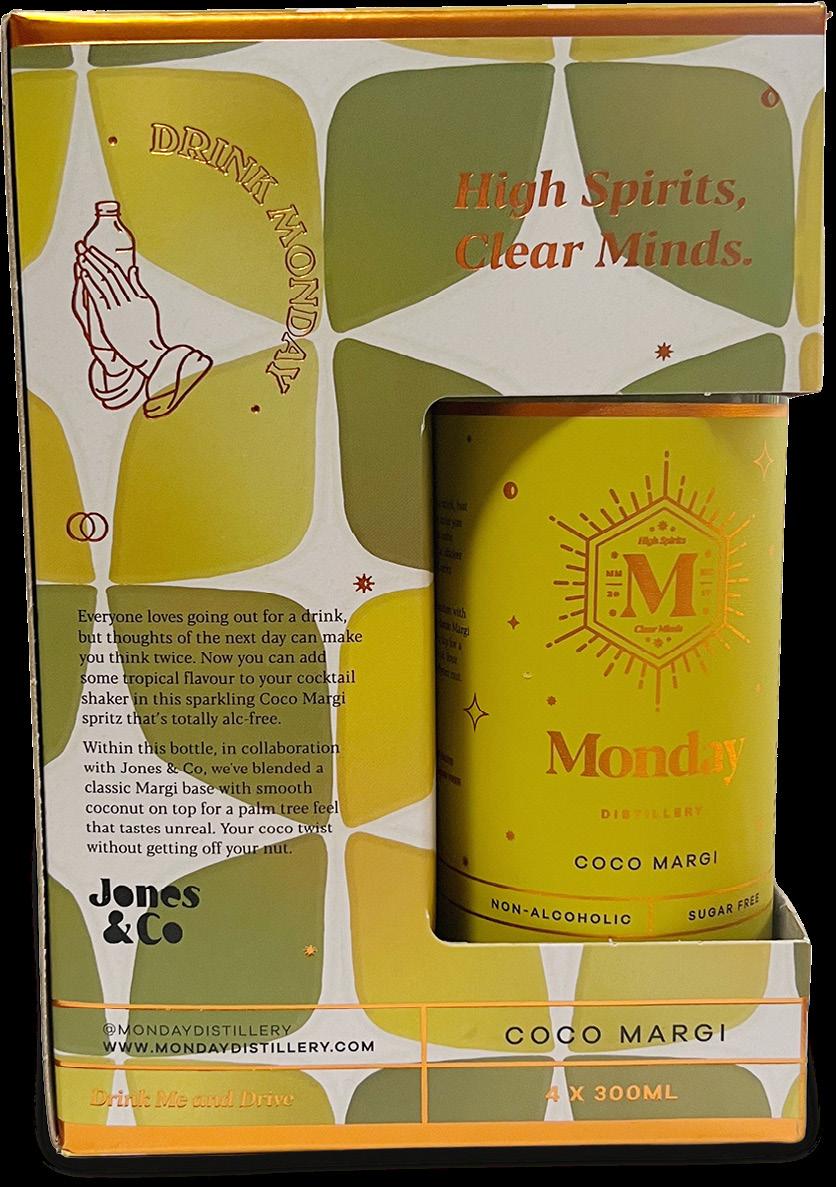

Heaps Normal’s limited-edition Coffee Run Stout brings a new meaning to the term ‘breakfast beer’. Brewed in collaboration with Newcastle-based ‘bean queen’ Kristy ‘Kmac’ Mujana at Floozy Coffee Roasters, the beer blends the roast malt sweetness of a stout with Floozy’s pineapple, cherry and dulce de leche-forward Golden Hour bean blend.
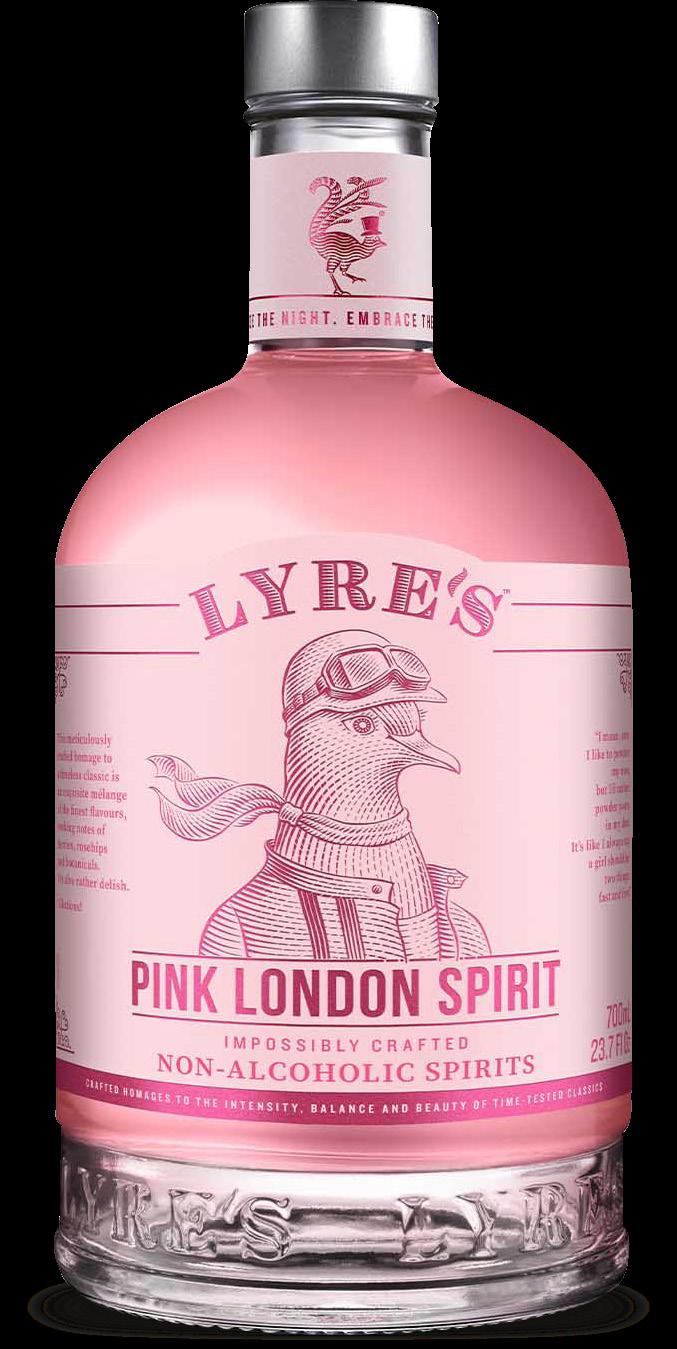
This unique spirit has been impossibly crafted to capture the essence of a pink gin, with flavours that are distinct and contemporary. On the nose it offers rich scents of red fruits such as raspberry, strawberry, and red currant, with added complexity of the underlying rosehip. The palate provides instantly floral notes of rose, cherry, red berry, and blackberry, supported by a generous gin-focused finish. The Pink London Spirit is vegan, and free of dairy, nuts, eggs, and gluten, allowing as many people to enjoy the spirit as possible. Plus, 10 per cent of online sales are donated to the McGrath Foundation.

With Naked Life, not drinking doesn’t mean going without. The multi-award winning Negroni Spritz is the perfect balance of bitter, sweet and complex. A uniquely crafted blend of cherry, apple, lemon and orange extracts, whilst delivering characteristic bitterness through cinchona and bitter orange extracts. Part of Australia’s number one non-alcoholic cocktail range, Naked Life, distributed by Craft Revolution.
After Australian lagers stole headlines towards the end of last year, Beer and Brewer felt it was high time to see just what the bottom fermenting landscape looks like at the start of a new year. Within the seasonal lager focus, there’s plenty of high quality variety that shows the category’s recent revival should no doubt continue apace right across the country.
Jono Outred, WA
Based in Margaret River, Jono is a beer writer that predominantly covers the South West of WA. He’s been involved in the state’s beer industry in various capacities since 2011.

David Ward, ACT
Head of sales for BentSpoke Brewing Co and with over 10 years’ experience working in the craft beer industry, David is constantly on the lookout for new beers to try and trends to watch.
Tina Panoutsos, VIC
One of Australia’s leading beer judges, Tina is a beer sensory expert with over 30 years’ experience in the brewing industry in roles across technical and commercial functions.

Tom Pigott, NSW
The bar manager at Sydney’s Batch Brewing who used to run Uncle Hops in Newtown, Tom is also one of the hosts of the Pixels & Pints podcast.
Josh Quantrill, NSW
Josh is a Certified Cicerone® currently working at 4 Pines Brewing who has extensive experience in the beer industry in the UK and Australia.

Ian Kingham, NSW
That Beer Bloke, Ian’s decorated beer career has included judging at Australia’s best competitions while he’s currently the Sydney Royal’s Chair of Judges.

Michael Capaldo, NSW
National sales rep at Hop Products Australia, Michael is a qualified and experienced brewer and an accomplished beer judge (GABS, World Beer Cup, Indies, AIBA etc).


Jake Brandish, WA
Beer & Brewer’s HomeBrewer
Editor, Jake has a post-grad Dip in Brewing, is a BJCP judge, has brewed commercially and is an all round beer geek.
Adam Carswell, VIC
Based in Bendigo, Adam’s been the proprietor of the awardwinning Cambrian Hotel for almost a decade. He’s a passionate advocate of independent beer and traditional pub culture.
Mark Dowell, ACT
A beer broker for BentSpoke with a background in liquor retail, Mark is always trying new beers while appreciating the classics that bought us here.
Craig Butcher, SA
Based in the Barossa Valley, Craig has 20-plus years’ experience in the liquor industry including winery cellarhand, tastings and sales, newbie homebrewer and beermad bottleshop guy.
Liam Pereira, NSW
Liam is the group venue manager for Sydney’s Batch Brewing Co. A Certified Cicerone® and BJCP judge, he was previously general manager of Sydney Beer Week.






Evan Belogiannis, NSW
Evan has been brewing beer at Frenchies Bistro & Brewery for over two years. He’s on a neverending quest to find and brew the crispiest, tastiest lagers.
Vincent de Soyres, NSW
As co-owner and head brewer at Frenchies Bistro & Brewery, Vince develops award winning brews that extend beyond the limits of traditional beer categories and styles.
Joe Cook, SA
Founder of Beer Fans, Joe is a Certified Cicerone® beer server and beverage entrepreneur who lives with Coeliac Disease, giving him a unique perspective on the world of gluten free beers.



Tiffany Waldron, VIC
A Certified Cicerone®, National Beer Brands Manager for Beer


Fans and Pink Boots Australia President, Tiffany is focused on making changes in the world of beer through education and furthering beer culture beyond standard boundaries.
Benji Bowman, NSW
With six years of industry experience in Australian craft beer and cider, Benji is now the state sales manager at Local Drinks Collective, working to increase the footprint and awareness of independent liquor in Australia.
Scott Hargrave, NSW/QLD
Scott is Balter Brewing’s multiaward winning head brewer and a regular on some of Australia’s and the world’s most prestigious judging panels including the Great American Beer Festival and the World Beer Cup.

Jamie Webb-Smith, NSW
Previously a brewer at The Australian Brewery, Jamie is currently head brewer at Yulli’s Brews in Sydney. He’s a home brewer turned pro, who completed the NSW TAFE microbrewing course.


ABV: 3.5%
Style: Gluten Free Pale Ale
You’ll find it hard to find a better gluten free midstrength. As the name suggests, it’s built for sessioning with its crisp and refreshing nature along with honey and fruit spice notes. The subtle intensity reinforces its craft birthplace as TWØBAYS knocks this one out of the park.
Food: Backyard BBQ twobays.beer

ABV: 4.9%
Style: Tropical Pale Ale
An enjoyable, highly sessionable fruit forward pale with lots of tropical fruit aroma and flavour, pleasant haze and a soft, well-rounded mouthfeel. Gold with medium haze and a lingering off-white head, strong notes of passionfruit and rock melon lead the nose as these hop characters carry over across the palate, rounding out to a soft clean finish with pleasing low bitterness.
Food: Grilled lamb cutlets
greenbeacon.com.au
ABV: 8.0%
Style: Oat Cream NEIPA
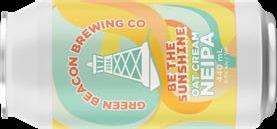
Pouring opaque with a golden haze that looks juicy and delicious, the aroma is in abundance of tropical fruits including pawpaw, passionfruit and pineapple. Whilst the flavours entice luscious, sticky sweet passionfruit and pineapple that is resinous on the front of the palate, it’s balanced by slight alcohol. Mouthfeel is thick, pillowy soft and creamy making this beer a delight to be tried by all!
Food: Passionfruit mousse greenbeacon.com.au
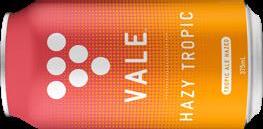
ABV: 5.2%
Style: Hazy Pale Ale
Fresh topical hop aromas and flavours are bountiful and while certainly hazy, it doesn’t go overboard, preferring rather balance to showcase the tropical and stone fruit hop flavours and bitterness. At 5.2% it packs a lot of flavour that wouldn’t be out of place in a 6%+ IPA. A great beer well suited to warmer climes.
Food: Fruit salad valebrewing.com.au
ABV: 8.0%
Style: Double Hazy IPA
Little Nipper’s bigger brother is remarkably well balanced for its ABV plus comes with all the haze and tropical hop character to be expected, all punctuated by a very clean but well-rounded mouthfeel. Pouring with a light golden haze and presenting a white rocky head, this is a beer to savour and drink while fresh.
Food: Dumplings fivebarrels.com.au
IPA
ABV: 6.5%
Style: NZ IPA
This enigmatic single hopped hazy IPA featuring experimental NZ Hops varietal NZH-102 displays flavours of strawberry ice cream, along with tropical and citrus notes. It is incredibly well integrated with the malt base, resulting in a delicious drinking experience.
Food: Classic beef burger hopnation.com.au

Pear Cider
ABV: 5.0%
Style: Pear Cider
Fruit flavour is subtle but the balance of acidity, length of finish, complexity and skill of the finished product is special. With light green influence in colour and low to medium low carbonation, this offers great refreshment and can be consumed on ice or enjoyed from a wine glass allowing the fruit aroma and palate to open up.
Food: Bacon roly poly sidewood.com.au
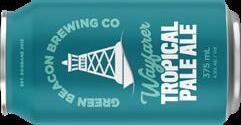
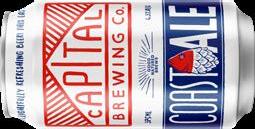
Coast Ale
ABV: 4.3% Style: California
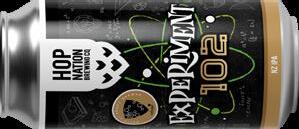
Common
Clear mid-straw with slight haze and moderate fluffy white foam, there’s whiffs of passionfruit, guava, mango and red berry before a wisp of sulphur on the finish. Red berry and light candy esters lead flavour with faint tropical hop notes in pursuit, while light sweet malt adds a clean, well weighted platform. Mouthfeel is rounded but clean and mild bittering allows maximum refreshment.
Food: Charred meats capitalbrewing.co
Summercloud
ABV: 5.4%
Style: Hazy Pale Ale
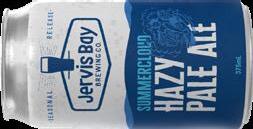
A wonderful expression of style, this has all the trademarks of a great beer. It pours beautifully with a persistent head and expresses tropical and balanced herbaceous notes on the aroma. Once on the palate it grows in complexity, exhibiting everything from dank, to floral to citrus all in one sip. The bitterness is well balanced for style.
Food: Seafood platter jervisbaybrewing.co
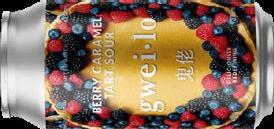
Sour
ABV: 4.9%
Style: Fruited Sour
Absolutely nailing the brief, this pours a hazy orange/ purple with low white head and offers aromas of fresh berries and vanilla custard, with a tart and sour element. It’s a fresh and fruity, mildly sour beer with vanilla and lactose balancing out the fruit and sourness wonderfully.
Food: Berry caramel custard tart gweilobeer.com.au
It’s prime time to be enjoying Shiraz, so this month our expert panel explored a wide range of Shiraz wines to find their top picks over three price brackets.
➤ Andrew Grahan, Journalist, Australian Wine Review
➤ Brydie Allen, Editor, National Liquor News
➤ Bryn Randall, National Business Manager, Accolade Wines
➤ David Fahey, Wine Consultant
➤ Jonathan Leeming, Brand Manager, Taylors Wines
➤ Masha Kyrychenko, Business Development Manager
➤ Michael Mcintosh, Fine Wine Brand Ambassador, Accolade Wines
➤ Seamus May, Journalist, Food and Beverage Media
➤ Tishena Young, National Account Executive, Constellation Brands
95-100 Classic: an exceptional wine
90-94 Outstanding: a wine of remarkable character



85-89 Very good: a wine with impressive qualities
Zema Estate Family Selection Shiraz


Region: Coonawarra
VIN: 2016 LUC: $49.99
Distributed by: Westwood Wine Agencies (VIC), Porter and Co (SA), Bacchus Wine Merchants (NSW/ACT), The Wine Tradition (QLD), Claret & Co (WA), David Johnstone & Associates (TAS)
“Restraint and careful winemaking came to the fore here. The vines have done the talking in the glass. Medium intensity but super balanced and super long finish.” –Michael Mcintosh
Bowerbird Syrah
Region: Sunbury



VIN: 2019 LUC: $22.58
Distributed by: Déjà Vu Wine Co.
“A welcome edge of leafiness in this Syrah style. Great depth of flavour and good tannins too.”
– Andrew Graham
Calabria Bros. Old Vine Shiraz

Region: Barossa
VIN: 2020 LUC: $11.82
Distributed by: Calabria Family Wine Group
“Lovely lifted nose, well balanced palate and good length.” – Bryn Randall
McWilliam’s Icon
Eliza Jane Shiraz

Region: Canberra
VIN: 2018 LUC: $60.20
Distributed by: Calabria Family Wine Group







“Blackberries and cocoa powder with cola and forest floor characters, charred wood and tobacco.” – Masha Kyrychenko
The Little Wine Company Little Gem
Shiraz
Region: Hunter Valley
VIN: 2017 LUC: $32.25
Distributed by: Single Vineyard Sellers
“Luscious berries with chocolate mousse, freshly cracked pepper, smashed black cherries and char. Touch of pleasant bitterness on the finish.”
- Masha Kyrychenko
Brown Brothers
Patricia Shiraz
Region: Victoria
VIN: 2018 LUC: $38.71
Distributed by: Brown Family Wine Group

“Voluptuous black cherry, plum and blackberry fruit are underpinned by notes of leather, savoury spice, dark chocolate and woodsmoke. Rich, decadent and full bodied.” – Jonathan Leeming
Brockenchack Jack Harrison Shiraz
Region: Eden Valley
VIN: 2016 LUC: $42.20
Distributed by: Brockenchack Wines
“Warming spice and blackberry fruit with tobacco, leading to a plush mid palate. Nice length.”
– Bryn Randall
“We do Shiraz well in Australia. The majority of cheaper wines over deliver at their price points, but some producers don’t showcase their fruit well, instead relying on alcohol and oak.”
Michael Mcintosh
Taylors The Pioneer Shiraz

Region: Clare Valley
VIN: 2015 LUC: $118.25
Distributed by: Taylors Wines
“Big blockbuster style. Ripe and unashamedly so aromatic. Deep berries and brambly notes add richness and juicy flavours.”
– Michael Mcintosh➤ “For lower alcohol wines, I would pair with pizza, charcuterie boards or even jerky.”
De Bortoli Rutherglen Estate Renaissance

Shiraz
Region: Rutherglen
VIN: 2019 LUC: $30.30
Distributed by: De Bortoli
“Ripe dark fruit, savoury midpalate and great balance and length.” – Bryn Randall

- Masha Kyrychenko
➤ “Ideally suited to a steak, but also will match a variety of pasta dishes.”
– David Fahey
➤ “A variety of red meats –kangaroo would pair well with a lot of the medium bodied styles.”
– Bryn Randall
➤ “Wagyu rump Bistecca style with a red wine jus.”
– Andrew Graham
Fine Wine Brand Ambassador Accolade Wines➤ Farmer’s Leap Shiraz 2021, Padthaway, LUC $14.60 (Farmer’s Leap Wines)

➤ Thorn-Clarke William Randell Shiraz 2018, Barossa, LUC $39.78 (Mezzanine)
➤ Brokenwood Tallawanta Vineyard Shiraz 2021, Hunter Valley, LUC $95.67 (Samuel Smith & Sons)

➤ Kalleske Moppa Shiraz 2021, Barossa, LUC $19.89 (Déjà Vu Wine Co.)

O’Leary Walker
Polish Hill River
Armagh Shiraz
Region: Clare Valley

VIN: 2020 LUC: $19.35
Distributed by: Negociants Australia
“Exuberant and enticing nose, offering sweet, decadent red plum and cherry. The palate follows, underpinned by cedar, sweet spice and black pepper.” –Jonathan Leeming
Taylors Jaraman Shiraz

Region: Clare Valley and McLaren Vale

VIN: 2020 LUC: $22.96
Distributed by: Taylors Wines
“Dark fruit, warming spices, reasonable balance and weight, decent length. This wine has better integration than a lot in this bracket.” – Bryn Randall
Château Tanunda
Grand Barossa

Shiraz
Region: Barossa
VIN: 2021 LUC: $16.87
Distributed by: Chateau Tanunda
“Very chocolatey in flavour and tannin profile. Plenty of blue and dark berries. Great structure, length and ageability. Well crafted and balanced.”
– Michael Mcintosh
Peter Lehmann

The Barossan Shiraz
Region: Barossa
VIN: 2020 LUC: $20.00
Distributed by: Casella Family Wine Group






“Firm oak nose with underlying red and black berry fruit. A good soft tannin finish.”
– David Fahey
Hungerford Hill Shiraz
Region: Hilltops
VIN: 2021 LUC: $21.50
Distributed by: Winestock
“Crushed tomato leaf, stewed blackberries with a touch of black pepper and earl grey tea.”
- Masha Kyrychenko
Pirathon Shiraz
Region: Barossa
VIN: 2018 LUC: $17.20
Distributed by: Déjà Vu Wine Co.
“An inviting wine with minty red and black fruit. Well balanced with nicely integrated tannins.” – David Fahey
“Great to see so many rich and flavoursome wines under $15 LUC! Awesome value.”
Andrew Graham Journalist Australian Wine Review
Richard Hamilton Little Road Shiraz
Region: McLaren Vale
VIN: 2020 LUC: $14.19
Distributed by: Leconfield Wines

“Lovely bright nose. Chocolate box, cedar and white pepper jostle for attention alongside blackberry, plum and baking spice.” – Jonathan Leeming
Shiraz
Region: McLaren Vale
VIN: 2021 LUC: $11.00
Distributed by: Accolade Wines
“Blackberry crumble dominates the nose with notes of sweet cherry. The palate is bright, fresh, clean and ripe, mostly primary but with good structure and poise.”
– Jonathan LeemingUppercut Premium Selection Showtime Shiraz



Region: Barossa
VIN: 2019 LUC: $12.95
Distributed by: Independent Beverage Partners
“Great medium bodied and easy drinking style. In balance and showing restraint.”







 – Michael Mcintosh
– Michael Mcintosh
Barton & Guestier Reserve Shiraz
Region: France
VIN: 2021 LUC: $14.85
Distributed by: Beach Avenue Wholesalers
“Notes of leather come through on the nose alongside sweet black fruit. Juicy black fruit, hints of dark chocolate and pepper on the palate with juicy, chewy tannins and long finish.”
– Jonathan Leeming
Region: Heathcote
VIN: 2020 LUC: $11.96
Distributed by: Brown Family Wine Group
“The palate holds together well with a bracing acid line, ripe juicy tannins and a mouthwatering finish.” –Jonathan
LeemingDee Vine Estate Range Shiraz
Region: Australia
VIN: 2021 LUC: $4.60
Distributed by: Dee Vine Estate
“Very easy drinking style with rich plush dark fruit, some peppery spice and oaky notes.” –Michael Mcintosh
“At the lower end of the price spectrum, many wines were somewhat monodimensional, displaying primary black fruit only. As the wines increased in price, more complex secondary and tertiary characters became evident.”
Jonathan Leeming Brand Manager Taylors Wines
“The wines weren’t overly tannic – a lot of juiciness in this lineup.”
Tishena National Account Executive Constellation BrandsYoung
Wine Experience is an independent retailer found in the leafy suburb of Paddington in Brisbane. The shop was first established in 2005, and has a pure focus on wine, with ‘no hops, malted barley, or grain to distract us from our devotion to the grape’, according to the store’s website.
The shop’s Digital Strategy specialist and self-described wine lover, Scott Baker, explains more.
“Wine Experience is a fine wine store offering the best of Australia (including our backyard, Queensland) and the world,” he says.
“We offer a true omnichannel experience, with bricks and mortar, wine bar and online. In every channel, we seek to support quality wine producers and tell their stories. We are wine people and take every opportunity to share our love of great wine. We also actively seek to promote and range wines unavailable at your regular bottle shop.”
One of the key unique selling points
for Wine Experience is its in-built bar, which also serves as the setting for twice-monthly masterclasses hosted by Andrew Corrigan MW.
“The wine bar at the front of our store is our real point of difference, it’s a cosy 13 person bar, offering interesting wine by the glass and 75ml tasting pours via the Coravin preservation system,” Baker said.

“We offer two wine classes per month at the wine bar. These are hugely popular events that always sell out quickly, as they allow people to learn and taste several wines in an informal setting. It’s a mix of locals and new customers and helps attract and retain wine-interested customers.”
Wine Experience also has an established online presence, and the store was an early adopter of e-commerce channels.
“We have been online since 2006, it’s always been recognised as a place we needed to be,” Baker says.
“The website has had several iterations,
and e-commerce has grown rapidly over the last few years, particularly during the pandemic and continues to be the fastestgrowing part of our business.”
Despite having been in the fine wine sector for nearly two decades, Wine Experience still has occasional difficulty keeping a steady supply of stock.
“Supply of the wines we love is an ongoing challenge as production is usually small. Allocation is a word being used more and more, and prices are rising rapidly for the most sought-after wines,” Baker comments.
Ultimately though, Wine Experience sees great success with the wine array that is stocks, thanks to the store’s staff who genuinely have a passion for the products they sell.
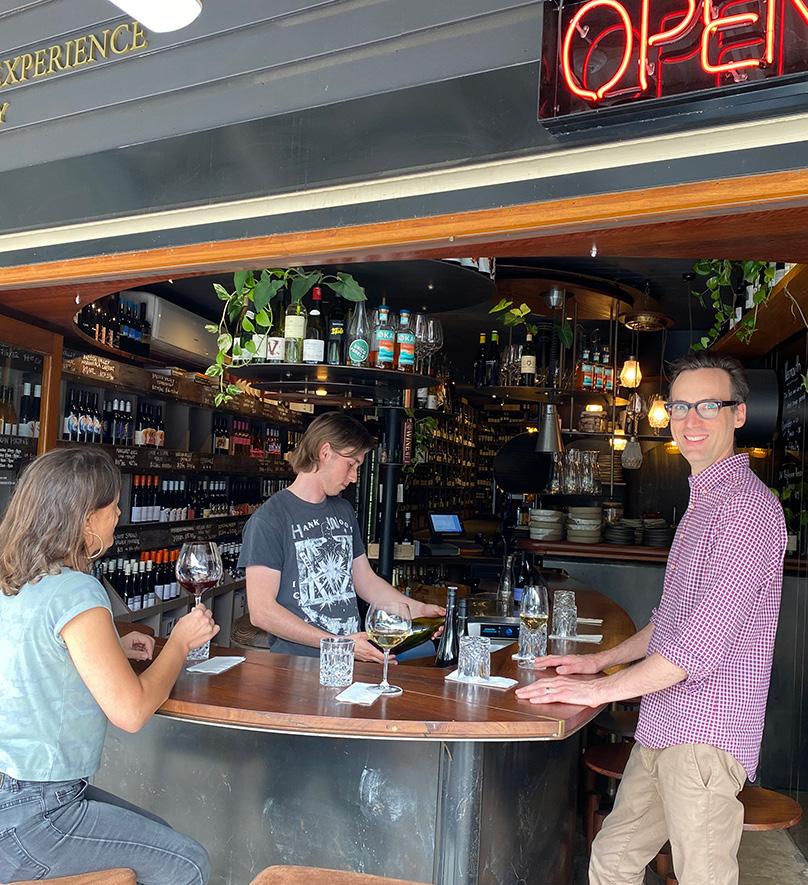
“We are a wine-only business with the core purpose of helping people explore all that makes wine such an amazing drink. We love wine, and we love sharing our passion and knowledge,” Baker concludes. ■
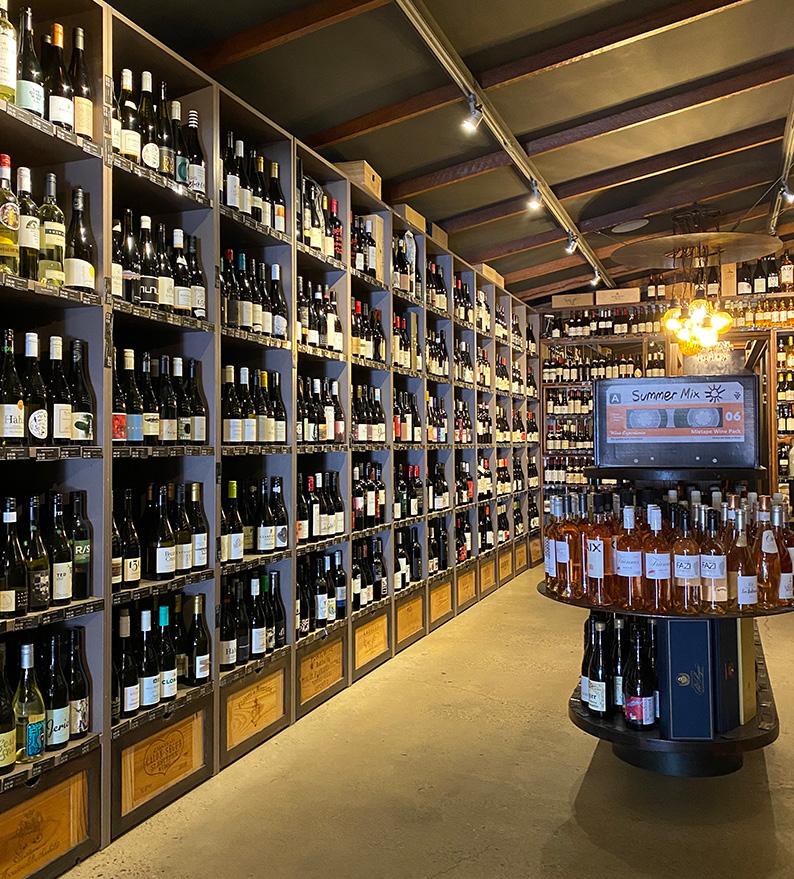 This independent store in Queensland has an in-house tasting bar, providing an exciting point of difference for customers, as Seamus May hears.
This independent store in Queensland has an in-house tasting bar, providing an exciting point of difference for customers, as Seamus May hears.
